Not a member? Join Us
Forgot your password?

Your cart is currently empty.

Trail MTB Frame P1 130mm
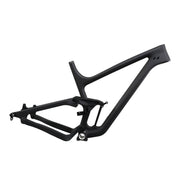
This frame is designed in the style of Trek Fuel, and can take 29er or 27.5+ wheels. The frame can take up 130-140mm fork in the front with 29er wheels and 140-150mm fork with 27.5+ wheels..
- 130mm travel size
- max tire size: 27.5 *2.8'' or 29* 2.3''
Recommended Matched mountain wheels: Trail F730 , Trail F930
P1 complete bike are available in stock!
Compare P1 and P9
P1 has 130mm travel and P9 has 150mm travel distance
P1 have 51mm rear shock travel,but P9 is 55mm
P1 is suitable for trail roads, P9 is suitable for enduro riding
NOTE: US customers, please, order from our US warehouse .
Tags: Full suspension MTB frame , Trail Bike Frame

Description
Specification.
Rear Shock Eye to Eye : 200*51mm or 200*57mm
Rear Shock Hardware: 22.2mmx8mm
Front Fork Travel: 130-140mm for 29er wheels (140-150mm for 27.5 plus wheels)
Disc Rotor size: 160mm
Supported Rear Shock :
- FOX Float DPS Factory
- Rockshox Monarch 200*51mm
Ready to build up your own light and durable carbon Trail/AM MTB frame? Or upgrade your current frame? No better place to start than with a quality and affordable carbon frame. This P1 frame from ICAN Cycling is a light in durable options for those looking for a full suspension with 130mm rear travel. Built with triple enforced T800 Carbon, a 31.6 seat tube for wider posts and dropper posts, and equipped with a durable, stiff, and low maintenance and durable BSA English Threaded bottom bracket, this frame is for those looking to be efficient, yet bomb decents with some big jumps thrown in. This frame is designed in the style of Trek Fuel, and can take 29er or 27.5+ wheels. The frame can take up 130-140mm fork in the front with 29er wheels and 140-150mm fork with 27.5+ wheels.
Can I use a 68mm bsa bottom bracket for a size large P1 frame?
XS-2350+-40g (UD Matt )
S-2380+-40g (UD Matt )
M -2 43 0+-40g (UD Matt )
L -2 47 0+-40g (UD Matt )
XL-2490+-40g (UD Matt )
The whole mountain bike world has gone boost crazy. This has probably made you feel like you want a boost frame. The only thing to hold you back has cost, well now we have built you the solution to your problem. Behold our carbon fibre full suspension boost mountain bike frame.
To keep prices down, we have concentrated on our R&D and not our marketing department or fancy name professionals. Nope, we are only interested in creating the best carbon fibre cycling products for you. Our boost frameset perfectly fits that mentality by being entirely up to date, very high quality and high tech but it does not feature a high price tag.
Instead of building with dollar or pound signs it comes bulging with features. The frame is constructed from Toray T700 carbon fibre. Allowing our engineers to create a lightweight and stiff frame. They have achieved extra stiffness by using a 148mm by 12mm rear end. Making it possible for the frame to become wider; this helps to stiffen up pivot joints and make them longer lasting.
With 130mm of travel and a BSA bottom bracket, you can be sure that this frame will be capable of taking you anywhere with a nice amount of travel and a reliable bottom bracket system. To add to the reliability, we have used our famous internal routing system for making sure your cables and hoses can be fitted quickly and easily.

IS ICAN WHEELS AND FRAME GOOD?
YES! Many customers have purchased wheels and frames of ICAN Cycling, and they give us many good feeback.All products undergo strict quality control and provide two years warranty .
WHY THE SAME PRODUCT HAS DIFFERENT PRICES The prices of the same products in different warehouses are different. We have prepaid taxes and freight for users who purchase products in overseas warehouses.
WHY THE WHEELSETS ARE TOO STIFF FOR HARDTAIL The reason may be that the spokes tension of wheels is too high. Please check that the spokes tension to make it at a the proper range.
Why do i feel the freehub is a bit tight when backpedal
When riding for the first time, freehub needs to run in with the wheels. Just ride for a while, freehub will run well.
WHAT IS DIFFERENCE BETWEEN AERO OR AERO SPECIAL?
Let us take Aero 40 and Aero 40S as an example. Have a look for their difference .
WHAT'S THE DIFFERENCE BETWEEN ICAN'S RIM ROAD WHEELS?
About the difference,you can check out the info from the image.

What is the difference between Alpha Disc and Aero Disc
The main difference between theses carbon road wheels is rim,spoke,hub.
1.Aero disc is lighter than Alpha disc,Aero disc use our superlight carbon rim . Alpha disc use our fast and light normal carbon rim .
2.Aero disc integrate Sapim CX-Ray Spokes ,Alpha disc integrate Pillar SA1423 Spokes. 3.Alpha Disc with ICAN D21 Hub, Aero disc with ICAN D01 Hub.
CAN ICAN WHEELS BE SET UP TUBELESS?
For ICAN’s current line up of wheels, most of wheels is tubeless compatible.
What is the best tire size for my ICAN wheels?
The best tire size for your wheel, which depends on the wheelsets type, size and the conditions you plan to ride the wheel in. If you focus on speed,aerodynamic, each carbon wheel will have a specific recomended tire width, which is listed on specific product pages under rim specs.
We find(Not necessarily 100% correct):
- With a broader external width, ICAN Cycling wheels roll most optimally with a 25mm/28mm (actual width) tire.
- For Jet wheels, we recommend 25mm (actual width) tires, but 28mm (actual width) tires are still an excellent choice.
- Unless a podium step hangs in the balance, the difference in the speed of the Jet, using a 25mm tire versus a 28mm tire, works out to only 0.05 kph. That’s approximately 3 – 4 seconds over 40km.
What is the recommended tire pressure
If you want the right tire pressure,please read the guide for recommended tire pressure .
What is the suitable spokes tension
MTB Wheels the front spoke tension :110 +-10 kilograms force Rear wheel drive side :120 +-10 kilograms force No drive side Rear :60% kilograms force of drive side Rear-wheel Road bike wheels spoke tension: front wheel: 110+-10 kg force Rear wheel: 120+-10 kg force
Recommended maximum spokes tension: Less than 145 kgf.
More spoke tension info here .
HOW TO SET UP TUBELESS TIRE TAPE?
More info about tubeless tire tape,to read the guide
How to track my order online?
Once your order has shipped, a Shipping Confirmation email is sent to you with the tracking website and the tracking number. You can use this tracking number to track your order via the carrier's tracking site. What is the processing time and delivery time for my order? We will ship out the item within 36 hr with careful package after the processing time .and it takes about 3-10 days if the stock running out. The delivery time will epends on the courier method.
Noted: Due to the impact of the epidemic, the arrival time of the goods will be delayed. Due to increased demand, this product will ship in 7 – 8 weeks. If have any questions,please contact us in time.
How to pay by credit card without paypal account
You can pay by credit card without paypal account. Check the payment guide here.
People who bought this product also bought
What are you looking for.
Giant Stance 29 Review | Full suspension fun for less
The not-so-minor details, giant stance 29 2.
Giant Bicycles
https://www.giant-bicycles.com
- Supple suspension performance - Comfortable & compliant ride quality - Usefully low-gearing - Smooth & reliable Shimano brakes - A lot of bike for the money
- Quick release dropouts limit upgrade potential - Rear-end flex may be an issue for heavier riders - Handlebars are far too narrow - Effective seat angle is quite slack
Wil reviews the Giant Stance 29
This time last year, Giant Bicycles released a new 29er version of its entry-level full suspension mountain bike, the Stance. Built around larger, smoother-rolling 29in wheels, the new Stance 29 is pitched as a modern, all-purpose trail bike. It features a lightweight alloy frame, a 130mm travel fork, 120mm of rear wheel travel courtesy of the FlexPoint suspension design, and geometry inspired by its more expensive sibling, the Trance 29.
The thing is though, the Stance 29 is cheaper – like, a lot cheaper. With a sticker price of just $2,399 AUD ($2,699 AUD for the 2021 model), not only is this one of the most accessible full suspension bikes on the market, it’s also over a grand less than the cheapest Trance. So just how different are they on the trail? To find out, we’ve been riding a Stance 29 2 for the past few months to see what it does well, what it doesn’t do so well, and whether this entry-level full susser earns our recommendation.
Watch our video review of the Giant Stance 29 2 here!

The Giant Stance is a lightweight full suspension trail bike that’s built around an alloy frame, a 130mm travel fork, and 120mm of rear wheel travel.
FlexPoint vs Maestro
While the two bikes share similar travel and intentions, the big difference between the Trance and the Stance can be found in the rear suspension layout. Whereas the Trance gets the dual-link Maestro platform (which is also used on the Anthem and Reign), the Stance is built around a single-pivot suspension design called FlexPoint. It gets this name due to the engineered flex that occurs through the seatstays on the one-piece swingarm. Compared to similar looking suspension designs, there is no pivot near the rear axle. Instead, the seatstays actually bend a few degrees as the suspension cycles through its travel.
That might sound a bit scary, but using flex stays is a popular technique amongst many other brands including Trek, Specialized and Cannondale. Scott has been using flex-stays for a number of years now on its 120mm travel Spark, both in alloy and carbon variants, and of course Giant has already used the design since 2015 on the 27.5in Stance. Still worried? It’s worth noting that just like every other Giant mountain bike, the Stance 29 comes with a lifetime warranty for the original owner.

While it doesn’t possess the same tuning capabilities as the dual-link Maestro platform when it comes to things like axle path and anti-squat, the key advantage of Giant’s FlexPoint design is that the overall layout is vastly simpler. That makes it cheaper to manufacture, and also potentially easier to live with from a maintenance perspective.
Ticking most of the boxes
The Stance 29’s frame is made from hydroformed and welded ALUXX alloy tubes, with the rear swingarm mounting to a chunky main pivot that sits both forward and above the bottom bracket shell. The shock is driven from above by a one-piece rocker link, while the other end shares the same anchor point as the main pivot. Again, this is all about reducing moving parts.

You’ll find a tapered zero-stack head tube, a press-fit bottom bracket shell, integrated chainstay armour, internal cable routing, and room for a water bottle on top of the downtube.
Giant has given the Stance 29 very similar lines to the Trance 29, and it ticks many of the same feature boxes for a modern trail bike. You’ll find a tapered zero-stack head tube, a press-fit bottom bracket shell, and integrated chainstay armour. There’s also room for a water bottle on top of the downtube, and the cables are routed inside it to keep things clean. Unfortunately the Stance 29 does miss out on a rear thru-axle though, instead sticking to quick-release dropouts. This is presumably a cost-saving decision on Giant’s behalf – no doubt an important consideration when you’re pumping out millions of bikes each year.
Trance-inspired geometry
One of the most exciting trends we’ve witnessed over the past few years is the adoption of contemporary geometry amongst entry-level mountain bikes. Good geometry essentially costs you nothing, and it can really transform the overall experience for those who are newer to the sport. On the flip-side though, making a trail bike too slack and too low can have the opposite effect for non-pro riders, making it awkward to ride at slower speeds.
On the Stance 29, Giant has aimed to find a balance with a reasonably slack 67.5° head angle, and fairly conservative reach measurements across all four frame sizes. The claimed seat tube angle is relatively steep at 75°, and to keep the rider’s weight low and centred between the wheels, the BB hangs 40mm below the hub axles, which is 5mm lower than on the Trance 29.

Regardless of rider height, each frame size is built around a 50mm stem length. However, they all come with a 690mm wide riserbar, which is unfashionably narrow these days. For comparison, Giant puts 780mm whoppers on the Anthem and Trance. More on that in a bit.
Giant Stance 29 price & specs
Giant offers two Stance 29 models internationally, but only the cheaper Stance 29 2 comes into Australia.
It’s a well spec’d bike for the money, with air-adjustable suspension front and rear courtesy of Suntour, including the beefy Raidon 34 fork up front. You also get a SRAM SX Eagle 1×12 drivetrain, Shimano hydraulic disc brakes, and tubeless compatible wheels. Along with its metallic red paint job and all-black suspension, it sure looks a whole lot more expensive than it is.
One thing to note is that Giant has just released the 2021 version of this bike, which is virtually identical save for a different drivetrain. Read on for the full review of the Stance 29, followed by a comparison to the 2021 model.

- Frame | ALUXX Alloy, FlexPoint Suspension Design, 120mm Travel
- Fork | SR Suntour Raidon 34 LO-R, Air-Spring, 51mm Offset, 130mm Travel
- Shock | SR Suntour Raidon R, 185×45mm
- Wheels | Giant XCT, Alloy Rims, Tubeless Ready, 25mm Inner Rim Width
- Tyres | Maxxis Forekaster EXO, Tubeless Ready, 29×2.35in Front & Rear
- Drivetrain | SRAM SX Eagle w/SX 30T Crankset & PG1230 11-50T Cassette
- Brakes | Shimano MT200 w/180mm Rotors
- Bar | Giant Connect Trail Riser, Alloy, 690mm Width
- Stem | Giant Contact Alloy, 35mm Clamp Diameter, 50mm Length
- Seatpost | Giant Alloy, 30.9mm Diameter, 0mm Travel
- Saddle | Giant Contact Neutral
- Available Sizes | Small, Medium, Large, & X-Large
- Confirmed Weight | 13.94kg (Medium, w/out pedals)
- RRP | $2,399 AUD

Testing the Giant Stance 29 2
With fewer bells and whistles than a pricier rig, the Stance 29 is a refreshingly simple bike to setup. There’s no dropper post, which affords a clutter-free cockpit. The Shimano brake levers are quite long, which is good for less experienced riders who may prefer to brake with two fingers. However, it’s still easy to mount them further inboard for one-finger braking. The reach adjust bolt is awkward to access, and it requires a tiny 2mm hex key. Get that set before your first ride though, and you won’t have to touch them again.
While both the rims and tyres are tubeless compatible, the Stance 29 comes fitted with inner tubes. For someone who’s newer to mountain biking, a tubed setup is for sure less hassle – you don’t have to worry about dealing with messy latex sealant, and you won’t need to pump up your tyres nearly as often. Don’t go too low on pressure though. I left the tubes in for the test period, and setup the Maxxis Forekasters with 22psi in the front and 26psi in the rear.

Suspension setup
You’ll need a shock pump to adjust the air pressure for both the fork and shock. Neither possesses an O-ring, so I lightly fitted a zip tie to the stanchion tubes to help measure sag and gauge how much travel I was using.
For the Suntour Raidon 34 fork, the recommended pressure is equal to your riding weight in kilos. ‘Riding weight’ means you, your riding gear, fanny pack, poncho – anything you wear while riding. For me, I set the air spring at 68psi to match my 68kg riding weight, and found the pressures to be pretty much bang-on. You can also adjust rebound speed via a red dial at the base of the fork. There are 20 clicks on offer, and I’d recommend trying it halfway to begin with. The adjustment range is absurdly wide though, so only adjust it one click at a time.
The rear suspension performs best with the shock set at 25% sag, which worked out at 120psi for me. As a result of the alloy flex-stays, the back end is quite lively and springy, so I ended up with the rebound dial only a couple of clicks off the slowest setting. Any faster than that, and I found I’d pogo around all over the place.

Both the fork and shock are air-sprung, allowing you to fine-tune the pressure to your specific weight and riding style.
Comfortable cruising
The first thing that struck me about riding the Stance 29 is just how comfortable it is. Out of the box, it delivers a taller and more recreational riding position compared to more hardcore trail bikes. The narrow bars emphasise this by pushing your chest upwards, helping to straighten your back. On longer cross-country rides and extended rail trail expeditions, I experienced less strain through my shoulders and upper back.
The suspension is also mighty smooth. Despite the entry-level designation, both the Suntour fork and shock are nice and supple, delivering a surprisingly floaty ride quality over rough terrain. Overall the suspension is noticeably smoother than the Polygon Siskiu D6 I tested recently , and the whole package is vastly more comfortable than a hardtail.

Contact points are fine. The fat rubber grips help to dampen vibrations further, though after a few crashes with some dirt ingress, they started to slip around. Lock-on grips would be a no-brainer upgrade. I also got along well with Giant’s own saddle, but being quite thin and narrow, it’s a curiously racy choice for an entry-level full susser.

Maxxis Forekasters aren’t my favourite tyre for trail riding, but they’re an excellent choice for this bike. The high volume casing provides decent absorption, and the low-profile tread rolls efficiently along hardpack surfaces. Coming in around 800g each, they’re also pretty light given their width.
Certainly in its stock configuration, the Stance 29 is an easy-riding bike for those who want comfort for bimbling along bike paths, rail trails, and dirt tracks in the bush.
Wide bars make all the difference
When riding on technical singletrack though, the high front end and narrow bars make it difficult to properly weight the front tyre. As well as feeling less stable overall, I was struggling to negotiate my way around sharper corners.
To remedy the situation, I tried out a 760mm wide handlebar. This widened my footprint over the front of the bike to improve stability, and it also brought my chest further down over the stem, increasing the effective reach while also lowering my centre of gravity. While it might not sound like much, the extra width completely changed the Stance 29’s personality.

Providing more leverage over the front wheel, the wider bars made the Stance 29 significantly easier to lean over to initiate a turn. It also gave me a more solid anchor point for moving around the cockpit. This bike has quite a light feel to its steering, which leads to great agility and lively handling on the trail. Along with the active suspension, it’s terrific fun pumping through undulations to build speed on modern machine-built flow trails. Despite the near-14kg weight, it’s plenty sporty.
Once up to speed, the Stance 29 also rolls well. There’s a fair bit of weight to the wheels (2,248g confirmed), so along with the speedy rubber and active suspension, the whole bike builds momentum quickly on the descents. If you’re pushing hard, the tyres will start to squirm though. There’s not a lot of support for the edging blocks on the Forekasters, and going to a meatier front tyre would elevate the confidence levels for the riders who are taking the Stance 29 to its limits.

Suspension performance
Depending on how you’re discovering those limits, you may also discover chassis flex through the back end. Of course the seatstay tubes are meant to flex vertically as the suspension goes through its travel, but the thin diameter tubes and slim quick-release dropouts mean it flexes in other directions too. Furthermore, the chainstay tubes on the Stance 29 are quite long. The main pivot mounts a little further forward compared to something like a Trek Fuel EX or Merida One-Twenty. And the longer a tube, the more opportunity there is for flex.
In the case of the Stance 29, you’ll notice this flex when pushing hard into berms and high-speed corners, where the rear wheel can be felt wandering off line. You can also detect some squirming when landing bigger jumps, particularly if the landing isn’t as smooth as you hoped. Certainly compared to the Fuel EX, One-Twenty and Siskiu D, there is a significantly softer and springier feel to the rear of the Stance 29.
What’s worth noting here is that I say this as a 68kg weakling. Riders closer to the 100kg mark are going to encounter significantly more flex than I ever could, and that is likely going to be distracting the faster and harder you ride.

In fact, for recreational riders and newer mountain bikers, the added compliance can actually help with both comfort and handling.
For the most part though, the flex isn’t necessarily a bad thing. In fact, for recreational riders and newer mountain bikers, the added compliance can actually help with both comfort and handling. Compared to a stiffer chassis, the Stance 29 doesn’t punish you so much for poor line choices, particularly when negotiating rock gardens of the choose-your-own-adventure variety. As long as you keep the front wheel pointing ahead, the rear wheel will follow, contorting its way around off-camber hits and ledges.
Simple but effective
Overall the simple FlexPoint suspension design performed a lot better than expected. With that main pivot sitting above and forward of the BB, there’s decent anti-squat, meaning the suspension naturally tightens up under more forceful pedalling. A lockout would be handy for riding on the road, but providing you practice a steady technique, it pedals fine.
I wouldn’t say technical climbing is this bike’s strong suit though. While Giant lists the seat angle as being 75°, the bent tube means that as you extend the seatpost, the effective seat angle actually becomes much slacker. At my preferred saddle height, I measured the angle at 73°. Combined with the offset seatpost, this puts the saddle quite far over the rear wheel. On steeper climbs, this increases your leverage over the rear shock. You sink deeper into the travel leading to more pedal bob, and wandering of the front end.
The best solution is to shove the saddle all the way forward on the rails, which improves the seated climbing position by pushing your hips further over the pedals. Ideally I’d like to see this bike would come with an in-line seatpost to begin with.

Admittedly, there is more feedback and less rear wheel traction on chunky climbs compared to the Trance 29 with its more sophisticated Maestro suspension linkage. And the Stance 29 tends to stiffen up somewhat under braking. Get a little overzealous with the rear brake, and the back end tends to clang and skid when descending down trails littered with loose rocks and moon-dust.
Component highs & lows
But I’ve otherwise been impressed by the Suntour suspension. No, the damping isn’t as refined as what you’ll find on a $4K bike. And both the fork and shock can become sticky at lower temperatures – something we noticed on early morning winter rides. But they still work well for the type of riding the Stance 29 is likely to encounter, and the fact that you can adjust both air pressure and rebound is brilliant. That makes it far easier to get the suspension setup correctly for your weight, and that will make a big difference to your overall experience with any full suspension bike.

I will say that the Raidon 34 is particularly smooth for a budget air-sprung fork. It offers a level of sensitivity that rivals a RockShox Revelation, and it is lightyears ahead of the horrible Suntour XCR 32 fork that comes on the Polygon Siskiu D6.
Unfortunately our test fork did develop some bushing play towards the end of the test period. This occurs when the fit between the upper tubes and the bushings inside the lowers becomes slightly too loose, resulting in a light knocking sensation that you can both feel and hear. In speaking with Bicycle Parts Wholesale, the Aussie distributor and service centre for Suntour, that is considered a manufacturing issue that would be rectified under warranty. Given we’ve experienced the same issue on high-end Fox and RockShox forks in the past, it’s certainly not a problem unique to Suntour.

Low gearing, smooth braking
Likewise, the SRAM SX Eagle drivetrain is basic, but I can’t confess to having any issues throughout testing. Like any SRAM Eagle drivetrain, setup on the rear derailleur is key. Get the cable tension, limit screws and B-tension setup correctly, and the shifting is fine. Given the mostly plastic construction, I expected the SX mech to explode on the trail, but no such explosions ever eventuated, even with plenty of wet and muddy winter riding.
I also had no issues with the Shimano brakes, which were reliable all throughout testing. Sure, they’re not the most powerful – you will discover the limits of the small rotors and resin pads when zooming down faster descents, and the resin pads also suffer in the wet. But they’re absolutely fine on intermediate trails and in dry conditions. In fact, I’d argue that the slightly softer and smoother braking performance is a good thing for beginner riders, since they’re less likely to lock up a tyre when panic-braking.

With a small 30T chainring and 50T cassette sprocket, the low gearing is fantastic – particularly given the Stance 29’s decent weight and big wheels.
What upgrades would you make?
There are no doubts the Giant Stance 29 2 is a quality bike out of the box. The frame has a great finish, with smooth lines that closely emulates the Trance 29. All the key load points are up to snuff too – the headset and hubs use sealed cartridge bearings, and SRAM’s DUB bottom bracket remained tight and quiet throughout testing.
If this were my bike though, there are a number of items on the upgrade list to take performance to the next level.
As mentioned above, wider bars transformed both the riding position and the handling. A decent alloy handlebar isn’t particularly expensive, though Giant really should be spec’ing a 740-760mm bar to begin with. After all, you can cut a bar down to make it narrower, but you can’t go the other way.

We’re also perplexed why there’s a bolt-up seat clamp given the rigid seatpost, which makes dropping or raising the saddle on the side of the trail annoying. Not helping the situation is the bent seat tube, which limits how far you can lower the seatpost. I’d ask my friendly Giant dealer to chop an inch of two off the seatpost, and to fit a $15 quick-release seat collar, both of which would making lowering the saddle on the descents much easier.
Of course if you have the cash, the best solution would be to fit a dropper post and be done with it. Giant’s own Contact Switch dropper post sells for a bit over $200, and the frame is ready for it with internal routing.
As your riding progresses further, a more aggressive front tyre would be a great addition to the Stance 29’s descending capabilities. You could also look at setting up the tyres tubeless. You’ll need rim tape, valves and sealant to do so, but going tubeless will reduce rolling mass while also allowing you to run lower pressures for a smoother ride with improved traction to boot.

Chopping down the seatpost and adding a quick-release seat collar would make trail-side saddle adjustments a lot easier, though the frame is also dropper-ready if you want to throw some cash at it. We’d also recommend wider bars and a tubeless upgrade.
The 2021 Giant Stance 29 – what’s changed?
Since finishing testing on our red Stance 29 2, Giant has released a 2021 model. The bike overall is virtually unchanged – it gets a new black paint job, but it still uses the same alloy frame, geometry, suspension design and Suntour fork and shock. The wheels and tyres are the same, as are the brakes.
What has changed is the move from SRAM SX Eagle to a Shimano Deore 1×12 drivetrain. You’re still getting 12 speeds at the back, but the range is bigger with the 10-51T cassette. The Deore components are also noticeably sturdier in their construction, and I suspect it’ll be more sought-after amongst consumers.
With the new model the price has also changed, going up $300 to $2,699 AUD. It’s not quite as sharp against competitors like the Merida One-Twenty and the Norco Fluid FS , but it’s still good value. And it’s also still $1,100 cheaper than the new Trance X .

Flow’s Verdict
The Giant Stance 29 ticks a lot of boxes for an entry-level full suspension bike. It’s a great package for the money, with quality disc brakes, tubeless compatible wheels and low-range 1×12 gearing. And being a bike that you purchase through a Giant dealership, it also comes with backup service and warranty support that can be particularly important for those who are investing in their first full suspension bike.
It isn’t just about price though, because the Stance 29 rides well. The suspension is smooth and easy to setup, and the 29in wheels give it great momentum over rough ground. Along with its comfortable and upright riding position, the Stance 29 is very approachable for someone who’s new to mountain biking. And as your riding progresses, upgrading to a wider handlebar and a dropper post will unlock further performance for pushing harder and faster.
The flexy back end is likely to be an issue for heavier riders though, who may simply find it too twisty on speedier trails. The quick-release dropouts also limit upgrade potential down the line, but if bigger upgrades are on the agenda, those riders will want to think seriously about spending the extra cash up front for the Trance 29 or Trance X.
For most riders though, the Stance 29 will be more than up to the task. No, it isn’t perfect, but as an entry-point into the world of full suspension, this bike is comfortable, smooth and just straight-up fun to ride.

- Submit for Review
- Terms & Conditions
Enjoy reading this?
Get similar articles delivered directly to your inbox
Gear-obsessed editors choose every product we review. We may earn commission if you buy from a link. How we test gear.
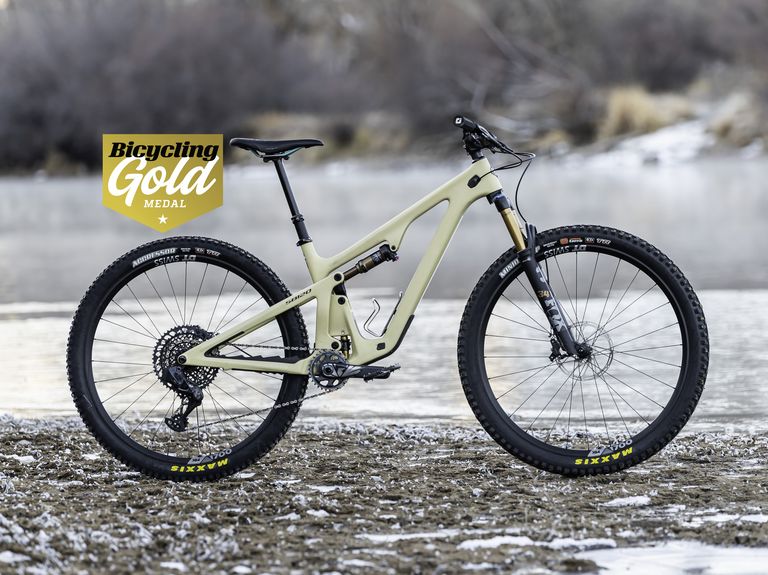
Reviewed: Yeti's Brilliant New SB120
In a field of great trail bikes, the new SB120 arrives as one of the best.
Builds and Prices
Ride impressions.
The Takeaway: The Yeti the world has waited for is here, and it is great.
- All new 120mm frame platform
- Offered in size extra small through double extra large with size-specific seat tube angles and chain stay lengths.
- Five builds starting at $6,300.
Yeti SB120 T1 GX X01
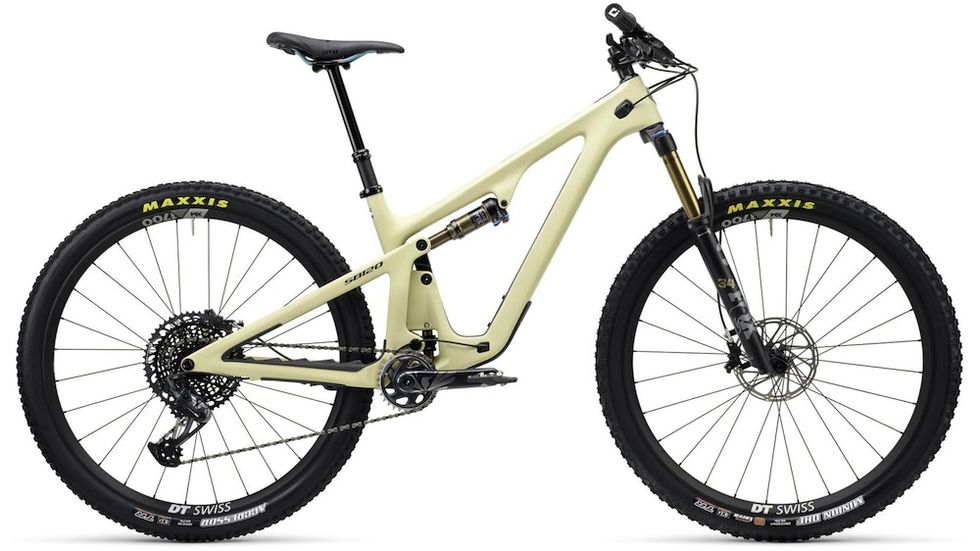
In 2014, Yeti debuted the Switch Infinity link , and it became the backbone of its full suspension bikes ( save the 160E e-bike) . But Switch Infinity (SI) debuted on a 27.5 bike, and Yeti didn't roll out its first 29er until a year later with the SB4.5c .

The 4.5c (previously, Yeti named models for inches of travel) had 114mm rear travel paired with a 140mm fork. It was a general-purpose and efficient all-purpose trail bike.
In contrast, the SB115 was an evolution—it used the same front and rear triangles—of the 100mm travel SB100 (a bike that was almost a cross-country race bike). Though the SB115 had a bit more travel than the SB100, it couldn’t shake the feel and handling of an XC bike. This handling was partly due to the geometry based on what was originally a shorter travel frame. The SB100/115 also used a unique interpretation of the Switch Infinity design—a smaller link in a transverse layout—while the SB120 uses the inline placement of the full-size link as the 4.5c and all other Switch Infinity bikes.
The SB100 (and 115) was a great bike, and somewhat forward-looking. It arrived on the scene well before the Transition Spur, Revel Ranger, Ibis Exie, and Allied BC40. But it couldn’t hide that Yeti had a gaping hole in its product line. Of all the brands you would expect to have a gravity-influenced fast and lively trail bike that is not afraid to get rowdy—something along the lines of an Evil Following, Santa Cruz Tallboy, Ibis Ripley (and others)—it would be Yeti.
But the SB115 wasn’t that bike: It was like baggy shorts pulled over a skinsuit. The SB120, in contrast, is a T-shirt and jorts, commando style. It’s the Yeti for which we have been waiting. And it’s great.

Frame Details
Although this is an all-new frame for Yeti, the SB120 shares a similar profile with the new SB160 . The SB120 also incorporates many details the company introduced with that longer-travel frame. Those details include: Clamping hose and housing ports with full-length routing tubes, clamping hose/housing keepers at the bottom bracket, second-generation Switch Infinity link for Turq series frames, aluminum BSA threaded bottom bracket with ISCG05 tabs co-molded into the carbon frame, double density downtube protector, revised pivot bearing arrangement, standard sized Enduro Max pivot bearings, SRAM UDH derailleur hanger, frame-size specific chainstay lengths and seat tube angles, and a higher-clearance downtube.
All Yeti frames (including the Switch Infinity link) carry a lifetime warranty against manufacturing defects and a one-year on paint and finish. For damage and failures that fall outside of the warranty period, Yeti offers a discounted replacement policy.
The SB120 arrives in six sizes (extra small through double extra-large) and four colors (Turquoise, Dust, Raw Carbon, and Loch).
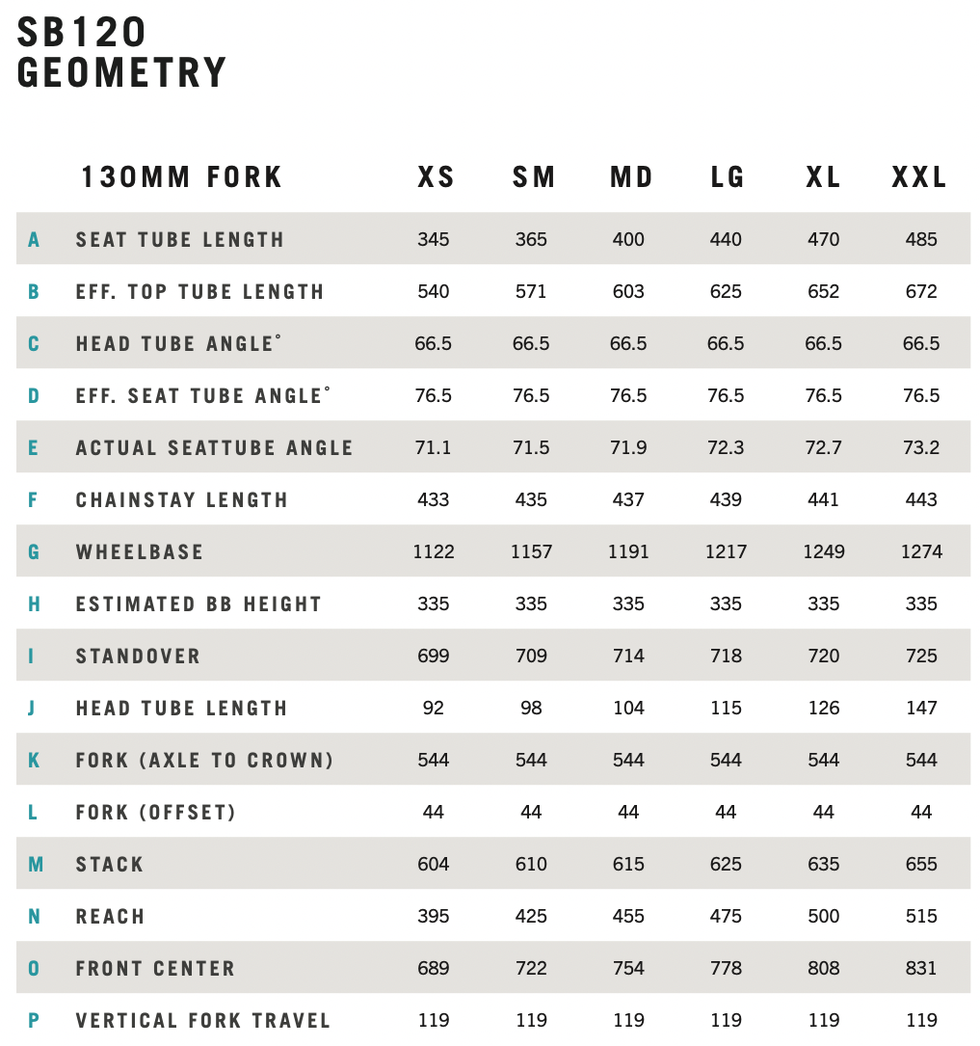
Pasted here is Yeti’s geometry table so you can nerd out on the numbers for your size. Though I don’t think you’ll find anything too surprising in the angles or dimensions. Now that everybody’s geometry is “progressive”, no one's is.
That’s clear in the comparison table I made of the SB120’s geometry compared to that of its major competitors. And that competition is crazy fierce: Some of the most popular, best-known, and just plain best trail bikes live in this category. And as you can see, every brand has arrived at very similar numbers.

Honestly, I was surprised because geometry evolution has been such a story for the past few years that I expected to see more risk-takers or outliers. However, not shown in my chart is that the SB120 is one of a limited number of brands that use size-specific seat tube angles and chainstay lengths. The Santa Cruz Tallboy is the only other frame in this group offering both.
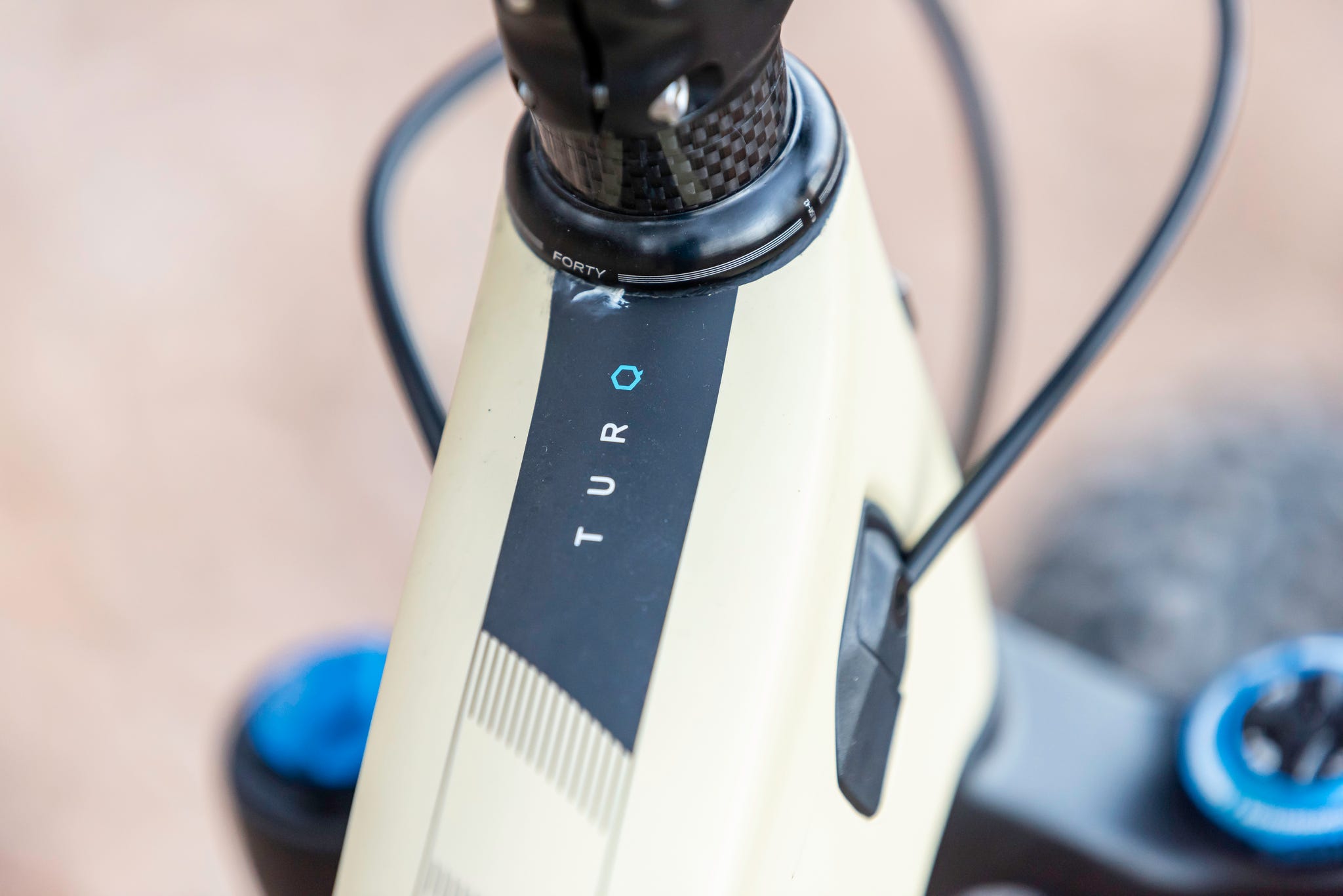
Yeti’s premium pricing should not surprise those who have been mountain biking for a while. This company only makes high-end products. SB120 complete builds start at $6,300 and top out at $12,100.
Like other platforms in its line, the SB120’s frame comes in two levels: Turq and Carbon. Although both frames have similar strength and stiffness levels, Turq SB120 frames have a claimed weight of 3,100 grams, while Carbon frames are approximately 225 grams heavier because they use lower-grade carbon. Other than the carbon recipe, both frames have almost identical details and features; the Switch Infinity link being a notable exception. While Carbon frames continue to use the V1 Switch Infinity link, Turq frames get the new V2 link which boasts better durability, stiffness, and lower friction than the V1.
Yeti Yeti SB120 T3
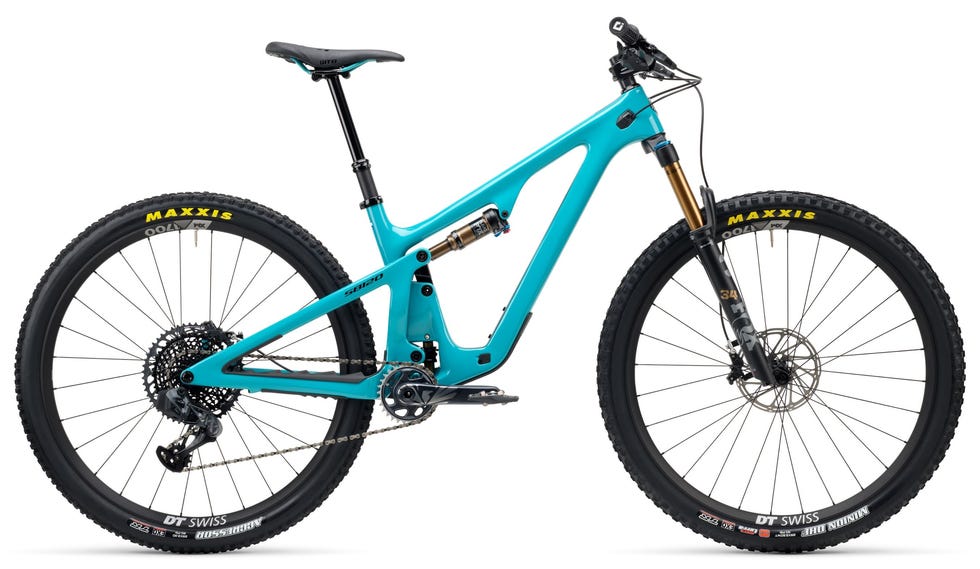
Most SB120 builds follow Yeti’s familiar recipes: Fox suspension, Maxxis tires, and SRAM drivetrain and brakes. The only exception is the least expensive C1 build with Shimano SLX drivetrain and brakes. The highest-end SB120 is the T4 “pinner” build ($12,100) and is the lightest full suspension bike in Yeti’s line (claimed weight is 27.3 lb.). To cut weight, the T4 gets two-piston SRAM Level brakes, Fox’s Transfer SL dropper post (125mm travel on size XS and S, 150mm travel for M through XXL) Fox’s lighter FIT4 fork damper with lockout, a 760mm wide bar, Maxxis Rekon (front) and Rekon Race (rear) tires, the “CNC” version of Burgtec’s Enduro MK3 stem, and the DT-Swiss EXC1501 wheelset with carbon rims.

C-series builds offer an optional upgrade to Fox Factory suspension for $800, while the T1 and T3 builds have an optional upgrade to the DT-Swiss EXC1501 wheelset for $1,000. Yeti also sells the Turq frame only for $4,300. Full build details are on Yeti’s website, but here are the highlights.
- Yeti SB120 C1 - $6,300 , Fox Performance 34 fork, Fox Performance Float DPS shock, Shimano SLX drivetrain and brakes, Crank Brothers Synthesis Enduro wheelset, OneUp Dropper
- Yeti SB120 C2 - $6,600 , Fox Performance 34 fork, Fox Performance Float DPS shock, SRAM GX Eagle drivetrain, SRAM G2 R brakes, Crank Brothers Synthesis Enduro wheelset, OneUp Dropper
- Yeti SB120 T1 - $8,200 , Fox Factory 34 Fork, Fox Factory Float DPS shock, SRAM Eagle mix drivetrain, SRAM G2 RSC brakes, DT Swiss XM1700 wheelset, Fox Transfer dropper
- Yeti SB120 T3 - $9,600 , Fox Factory 34 Fork, Fox Factory Float DPS shock, SRAM Eagle AXS mix drivetrain, SRAM G2 RSC brakes, DT Swiss XM1700 wheelset, Fox Transfer dropper
- Yeti SB120 T4 - $12,100, Fox Factory 34 Fork, Fox Factory Float DPS shock, SRAM XX1 Eagle AXS drivetrain, SRAM Level Ultimate brakes, DT Swiss EXC1501 wheelset, Fox Transfer SL dropper.
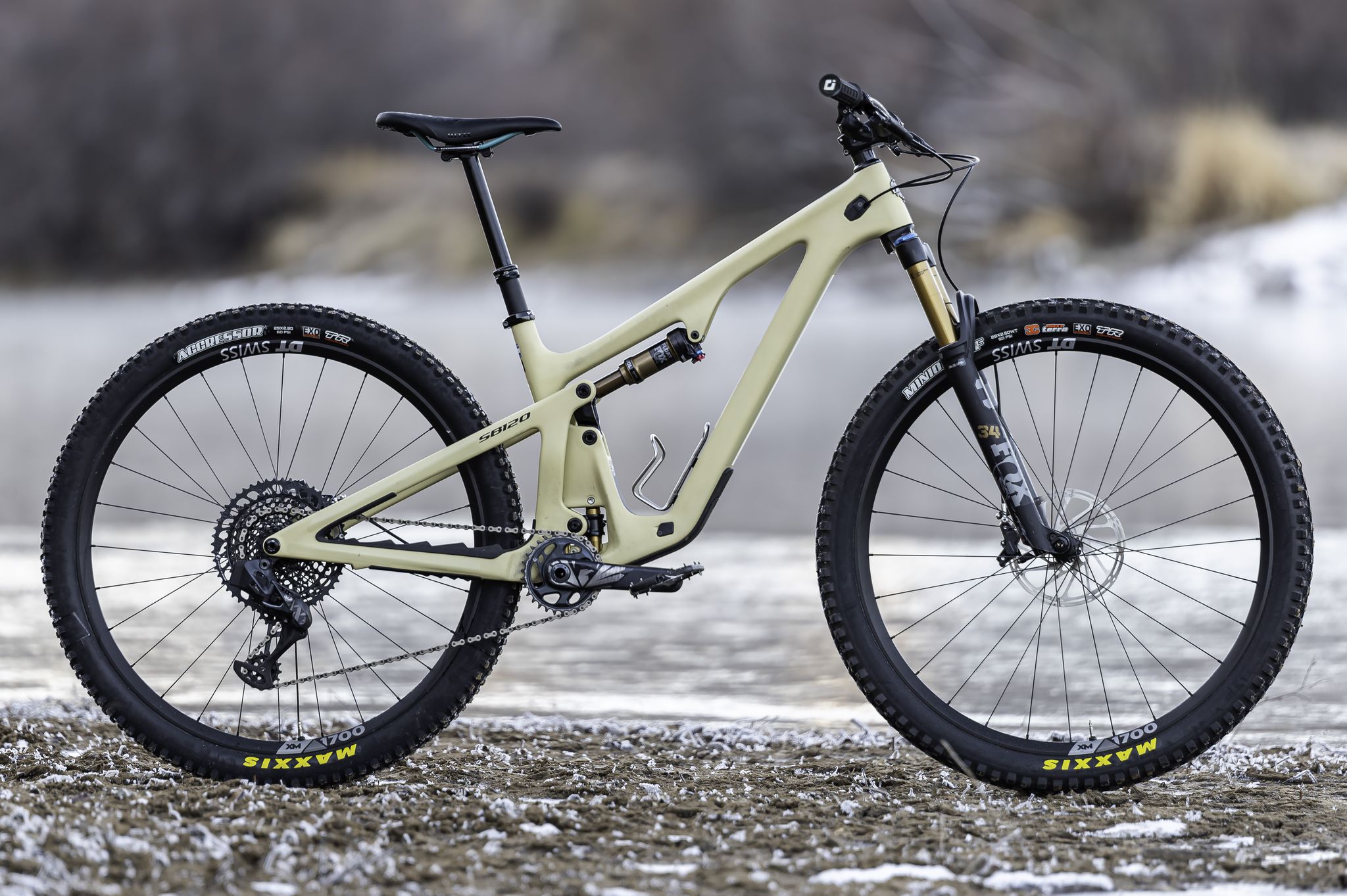
Like all bike reviewers, I have my favorite bikes. And I’ve long loved Yeti bikes. The geometry, handling, and suspension characteristics work for me. This may be because we’re both based in Colorado.
Here’s a dirty bike industry secret: Most bikes make the most sense when ridden on the trails the brands use to test and develop those bikes.
But my favorite style of trail bike was the one kind Yeti didn’t make: The 120/130mm rowdy/playful but surprisingly capable trail bike exemplified by the Evil Following and Santa Cruz Tallboy. The SB120 fixes that and is an excellent addition to a category filled with amazing bikes.
Looking at the SB120 from a high-altitude view, I’m hard-pressed to say anything about it that I haven’t already said about its competitors. If you’re looking for a mountain bike that’s equal parts a proficient climber, capable on descents both fast and chunky, efficient when pedaling long and lower angle traverses, engaging and fun while doing it all, and doesn’t weigh a ton, that’s the SB120.
On climbs, the Switch Infinity suspension system performs like I’ve come to expect. The feel at the pedals is firm and the frame stays calm until disturbed by a bump. For all its efficiency, the SB120’s rear end is also very sensitive, provides great traction, and also tracks smoothly over ledges and roots. Overall the suspension feel is slightly firm and very supportive in a way that implies a stiff ride. But it is surprisingly forgiving and supple.
On seated climbs, the SB120’s steep, but not too steep, seat angle provides a comfortably forward pedaling position on steeper pitches. Thankfully, this excellent climbing position doesn’t result in a cramped feeling on flat trails and mellower pitches where the longer-ish top tube provides enough room to stretch out and open the lungs.
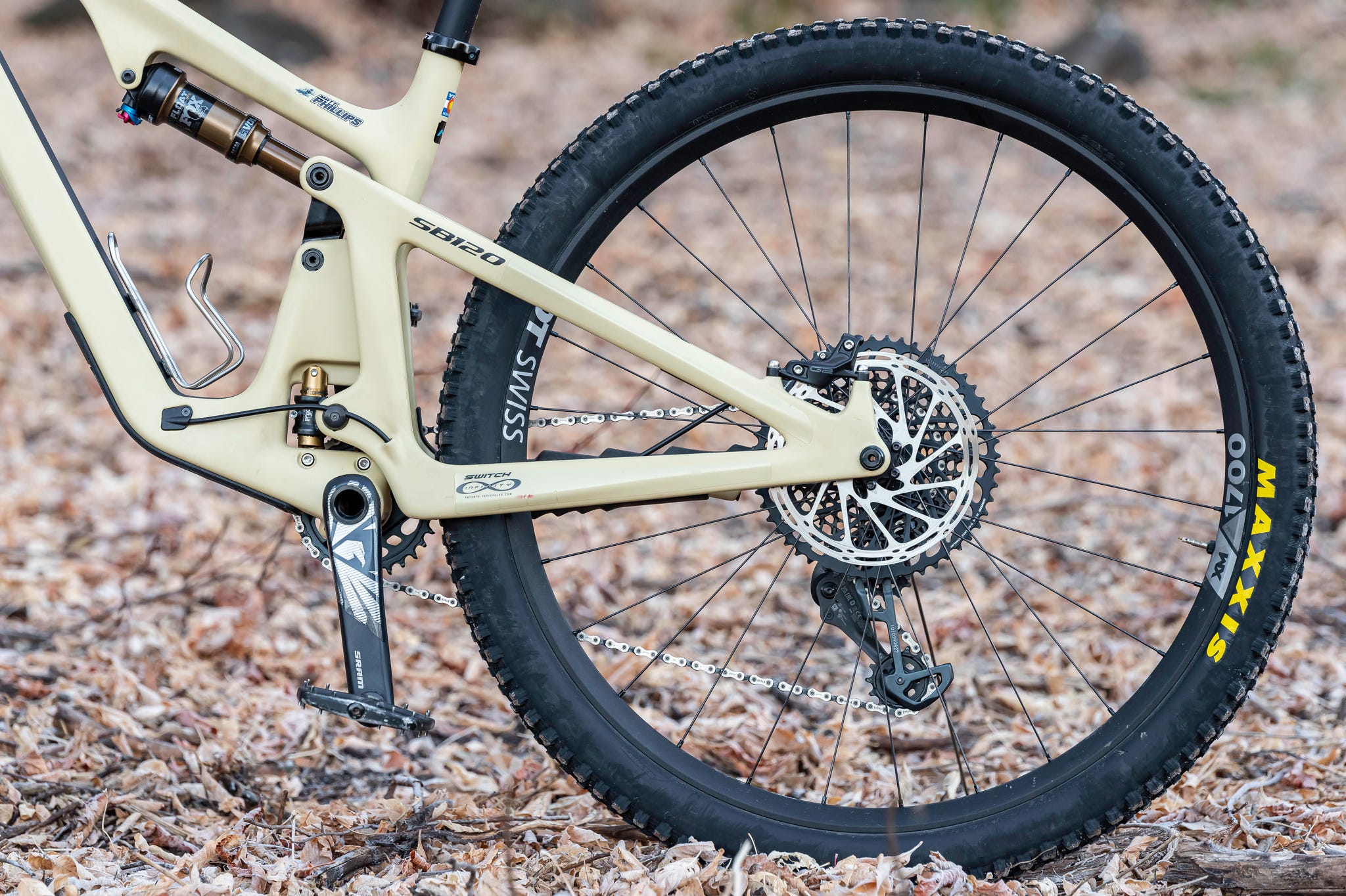
On the descents, the Switch Infinity is as impressive as it is on the climbs. Keeping in mind that this bike runs just 120mm of travel and has a lightweight inline Float DPS shock, the SB120 offers very good mid- to high-speed bump control. The rear end is progressive enough to keep the bike floating and skipping over repeated hard hits and control flatter landings.
While many shorter travel bikes have a rapid ramp at the end of the travel that almost feels like hitting a wall—and effectively limits usable travel—the SB120 offers good control and still lets the rider use the full 120mm travel. The medium bump feel is great also: There’s give and float with plenty of support. Square-edge hits are well handled too, with little hint that the SB120 is hanging up or slowing down.
The SB120 has well-balanced handling for most trail conditions. The handling is where you want it for a bike that the rider expects to climb well, descend with aplomb, and cruise flat trails, twisties, and traverses with a high level of competence. The SB120 is a bike that, even for this category, just slightly rewards good line choices and precision riding more than it does point and smash.
Part of that is due to the ever so slightly higher bottom bracket, steeper head angle, and shorter wheelbase than some bikes in this category, but there’s also that well-tuned rear suspension and balanced frame stiffness. It’s not just that the SB120 rewards good line choices and precision riding, it’s that it allows them. It’s been quite a while since I’ve ridden a bike that’s so balanced and intuitive feeling on the trail.
If there’s a knock against the SB120 it is the weight. The size medium SB120 (with a $9,600 T3 build I tested) weighs nearly 30 pounds. That’s approaching the weight of some bikes in the next travel category up (140mm-ish) . The SB120 is not an outlier in the category as some of its competitors also weigh close to 30 pounds. It’s the result of better suspension, more features, tougher wheels, better tires, and more durable frames .
Personally, I love the quicker and more communicative feel of what some might consider an overbuild short travel frame and usually prefer it to a bigger travel bike even if the bigger bike is nearly the same weight. But I also understand why some riders look at the weights of some of the most popular members of this 120mm category and choose to step up to a bigger bike that weighs only slightly more. Options are great, and there are many of them.
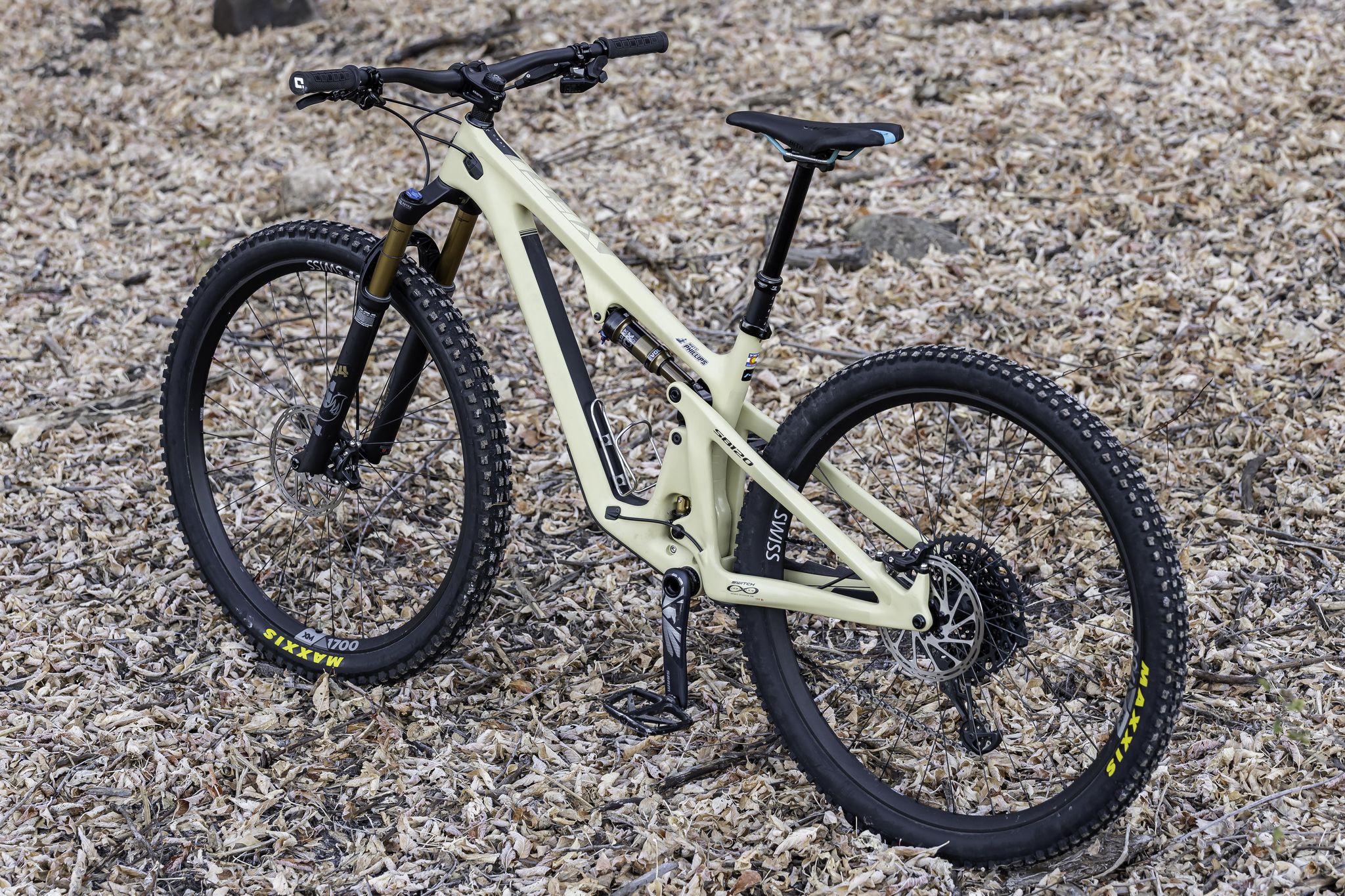
I do think it’s impossible to make a bad choice if you’re trying to decide between the SB120 and its primary competitors. Based on my experience, the SB120 has mellower steering than the Evil Following and Ibis Ripley but has better front wheel traction at medium and low speeds than the Tallboy. It pedals more efficiently than the Tallboy and Following, while the suspension is more sensitive than on the Pivot.
The rear suspension doesn’t feel as plush and deep as the Following or Tallboy’s, while it feels slightly, more smoothly linear than the Pivot’s. It’s more playful than most of its competitors, though not as hyperkinetic as the Evil. It climbs better than the Following and Tallboy (though for different reasons) and descends better than the Ripley and Trail 429. But I really, really , have to split hairs to say all that. Every one of those bikes is a god dammed marvel.
It’s almost like Yeti was able to take a Following, Tallboy, Ripley, and Trail 429, mash them up and sculpt one bike that almost exactly rides like a mashup of four great 120/130mm bikes. If you’ve wanted a bike that pedals like a Trail 429, pops like a Following, and descends like a Tallboy, the SB120 is that bike.

A gear editor for his entire career, Matt’s journey to becoming a leading cycling tech journalist started in 1995, and he’s been at it ever since; likely riding more cycling equipment than anyone on the planet along the way. Previous to his time with Bicycling , Matt worked in bike shops as a service manager, mechanic, and sales person. Based in Durango, Colorado, he enjoys riding and testing any and all kinds of bikes, so you’re just as likely to see him on a road bike dressed in Lycra at a Tuesday night worlds ride as you are to find him dressed in a full face helmet and pads riding a bike park on an enduro bike. He doesn’t race often, but he’s game for anything; having entered road races, criteriums, trials competitions, dual slalom, downhill races, enduros, stage races, short track, time trials, and gran fondos. Next up on his to-do list: a multi day bikepacking trip, and an e-bike race.

.css-1t6om3g:before{width:1.75rem;height:1.75rem;margin:0 0.625rem -0.125rem 0;content:'';display:inline-block;-webkit-background-size:1.25rem;background-size:1.25rem;background-color:#F8D811;color:#000;background-repeat:no-repeat;-webkit-background-position:center;background-position:center;}.loaded .css-1t6om3g:before{background-image:url(/_assets/design-tokens/bicycling/static/images/chevron-design-element.c42d609.svg);} Member Exclusive
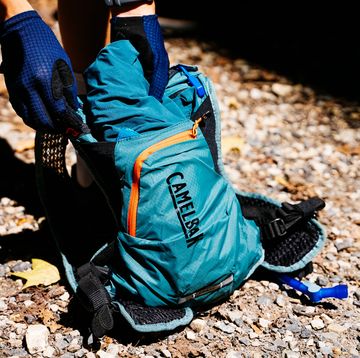
How Exactly to Do Bicycle Crunches
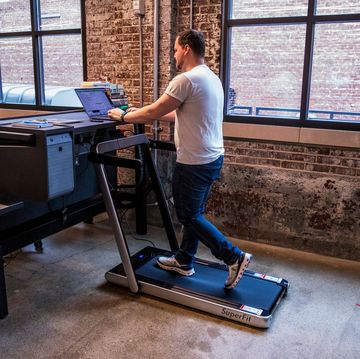
Want Boosted Brain Power? Walk While You Work
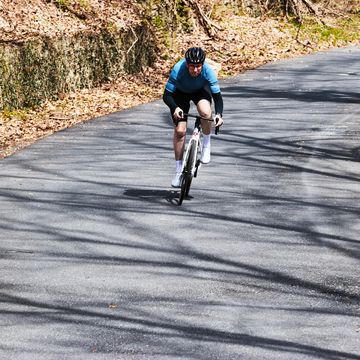
Strength Workouts to Help You Ride Faster
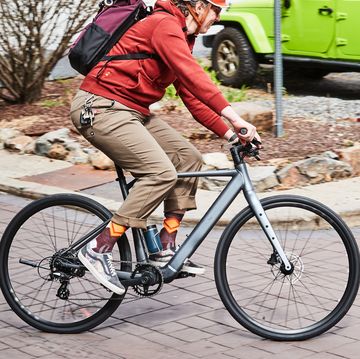
Everything You Need to Know About E-Bikes

How Collegiate Cycling Can Save American Racing
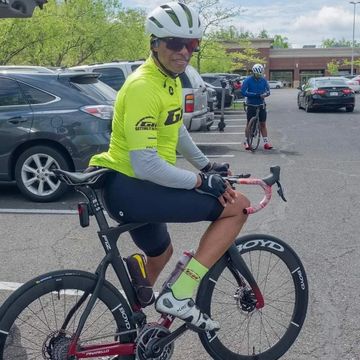
Cycling Tips for Older Riders
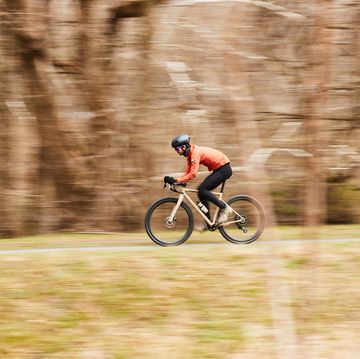
Your 4-Week Training Plan to Get Faster

Fresh New Mountain Bikes and Gear for Spring

Build a Strong Core With V-Ups
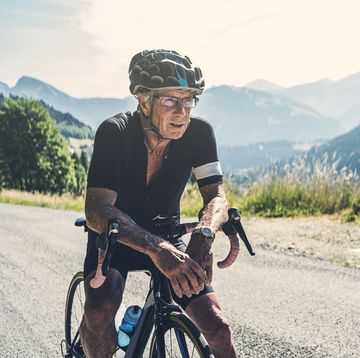
7 Expert Tips for Lowering Your Cholesterol
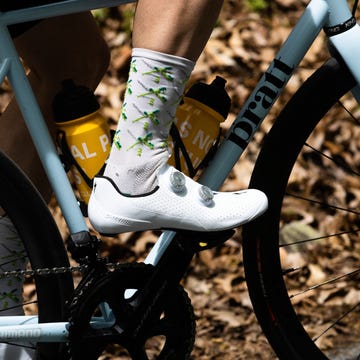
How to Improve Your Ankle Mobility
- E-Mythique LT
- Vitesse EVO
- Venon EVO-RS
- Venon EVO-GR
- Venon EVO-RS AERO
- E-Substance
- Energie EVO
- Mythique 24
- Mythique 26
- More Stories Tomorrow Collective
- Technical Support Documents
- Archive Bikes Post 2020
- Archive Bikes Pre 2020
- Mountain Downhill Dominer Enduro Sommet E-Sommet E-Mythique LT Trail/AM Escarpe Mythique E-Escarpe Trail Hardtail Nucleus Sentier E-Sentier Cross Country Rapide Rapide FS
- Road & Gravel Race ZX-1 EVO Vitesse EVO All-Road Venon EVO-RS Venon EVO-GR Venon EVO-RS AERO Performance Zenium Razor Gravel Substance E-Substance Cyclocross Energie EVO Energie Time Trial Auro
- E-Bikes MTB E-Sommet E-Escarpe E-Mythique LT E-Sentier City E-Mach 3 Road E-Substance Gravel E-Substance
- Hybrid Sport Mach 3 E-Mach 3 Utility Mach-1
- Kids Balance Bikes Nippy Smoothy Mini Rider (3-8y) 14 Kids 16 Kids 20 Kids 20+ Kids Big Rider (7+y) 24 Kids 24+ Kids Youth MTB (7+y) Mythique 24 Mythique 26 Nucleus 24 Nucleus 26 Youth Road/CX (7+y) Razor 24 Razor 26 Energie 24 Energie 26
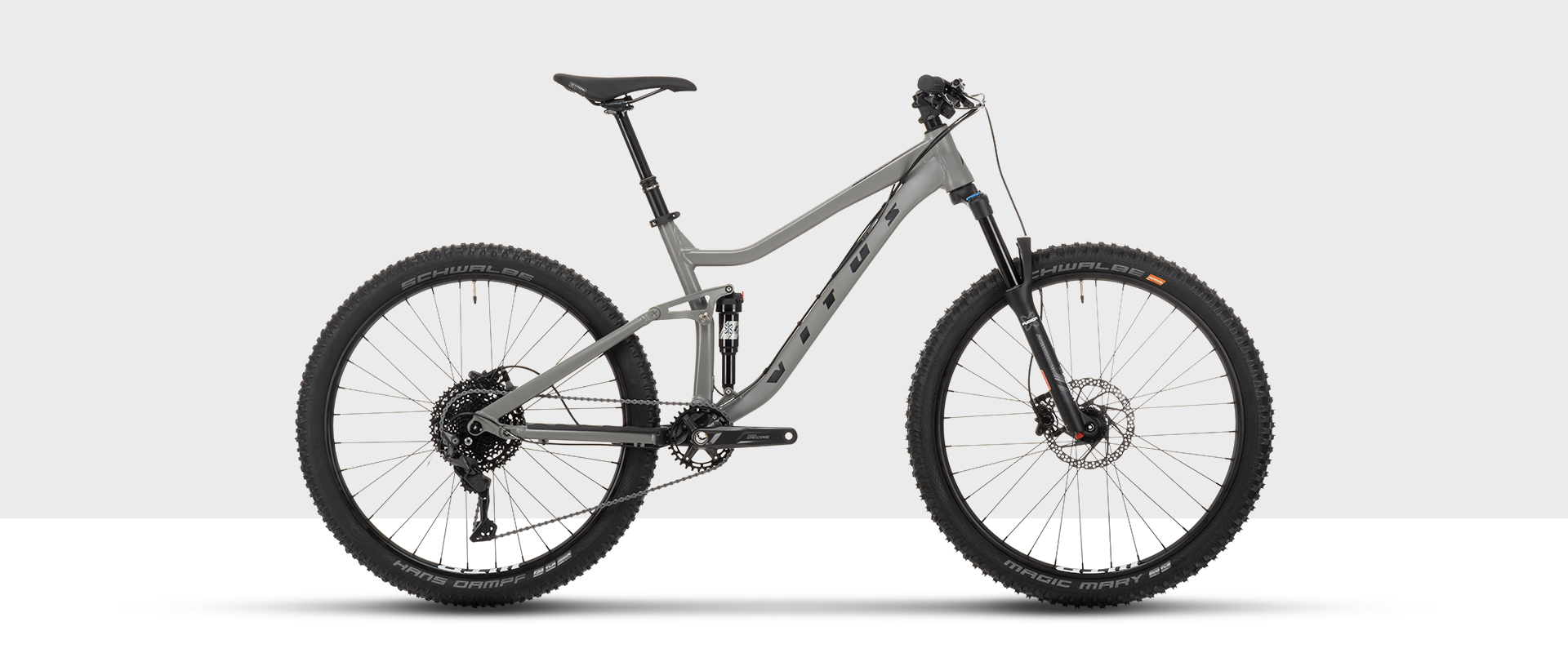
Vitus Mythique 27 VR Mountain Bike - £1,349.99
The capable and fun all round trail bike for all day ripping.
Now in its 2nd season the Mythique was developed around a proven horst-link 4-bar suspension design, allowing us to develop an accessible, capable and performance driven trail bike. Pairing modern geometry with dependable components and a setup that gives you the confidence to progress your riding to the next level. The Mythique is a bike capable of descending as well as it climbs. Watch the smile on your face widen as the Mythique encourages you to get out on the trails and shred section by section.
Out of the box the Mythique 27 VR is ready to hit your trail of choice. The 27 VR comes with 130mm in the frame travel, matched with X-Fusion suspension to keep you planted when the trails get rough. Shimano's 1x10 wide range Deore drivetrain provides reliable shifting for all day epics while the hydraulic disc brakes provide ample stopping power.
Rolling on WTB ST wheels and a Schwalbe Magic Mary / Hans Dampf tubeless ready tyre combo finished with Nukeproof components and a Brand-X Ascend dropper post you’ll have the confidence take your trail riding to the next level with our Mythique 27 VR.
*Due to volatility in the bicycle supply chain we may slightly alter the specification of the component parts supplied with this bicycle. Where this happens we have listed the alternate product in the specification table and have ensured that this is of either equivalent or superior specification to the stock component.
X-Fusion Suspension (130mm RC32 F)
- Shimano 1x10 M5100 Deore Drivetrain
- Shimano MT401 or Clarks M4 Brakes
- WTB i30 Rims
- Schwalbe Magic Mary/Hans Dampf Tyres
- Brand-X Ascend Dropper
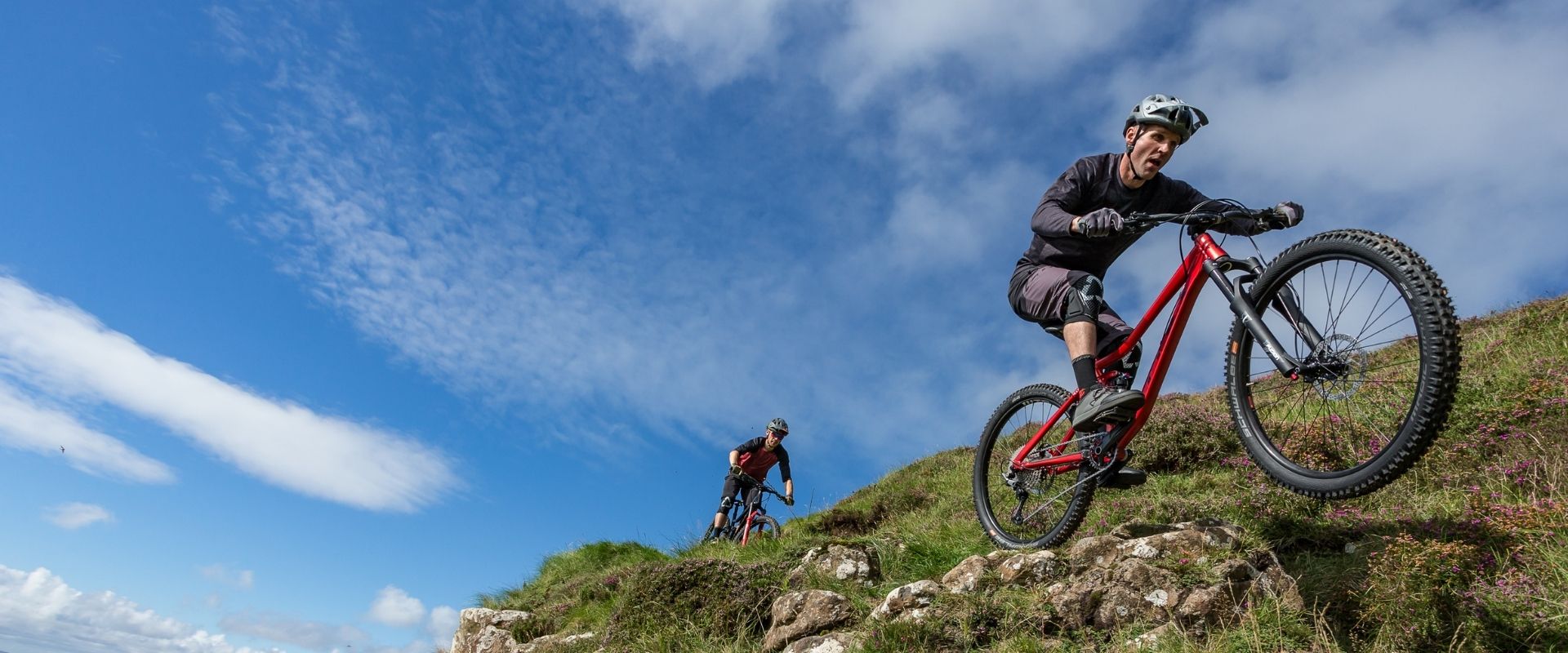
Specifications
Geometry & sizing.

- Where can I buy Vitus Bikes?
- You can buy Vitus bikes directly through our exclusive retailers Wiggle and Chain Reaction Cycles
- Do your bikes come with Warranty?
- We offer a 5-year warranty on all our frames. On top of that we also offer an extended 2-year warranty on all components excluding wear and tear items such as bearings, brake pads, chains & cassettes etc. Our Warranty policy applies to the original owner and processed by our exclusive retail partners.To see their warranty process check: CRC & Wiggle
- Where can I buy touch up paint for my bike?
- We have partnered up with paint specialist G-Paint to offer touch up paints for popular Vitus models. These can be bought direct from G-Paint's website HERE .
- Vitus Owners Manual
- Mythique - 2021 - Exploded Diagram Spare Parts
Shop with Preferred Partner

You may also like
@vitus bikes.
Best budget full-suspension bikes 2024 – full-sus performance has never been so affordable
Our expert picks of bargain full-suspension bikes that will help boost your control and confidence on any trail
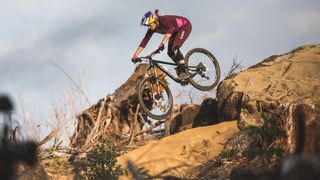
1. Best overall
2. best shorter travel bike, 3. best all-rounder, 4. best spec, 5. best for flowy trails, 6. best confident handling, 7. best lighter weight.
- How to choose
- How we test
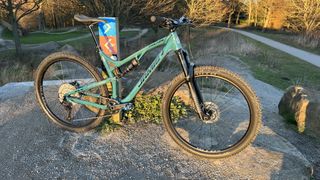
Quick list 1. Best overall 2. Best shorter travel 3. Best all-rounder 4. Best spec 5. Best for flowy trails 6. Best confident handling 7. Best lighter weight How to choose How we test
It used to be the case that there was little point in shopping for the best budget full-suspension bikes. The extra cost of adding pivots, a rear shock and a more complex frame design always meant that even the best full-suspension mountain bikes for those on a tighter budget had too many component compromises compared to the best hardtail MTBs , which delivered a really well-sorted ride. Often the suspension components or the frame were poor quality or outdated too.
Thankfully, there are now a number bikes out there that genuinely make riding more controlled and more fun than a hardtail and are good enough to be worth upgrading into something really good. So here’s our pick of the best budget full-suspension bikes to start your full-sus riding experience.
If you are unsure what to look for, skip to the bottom of this article to find out how to choose the best budget full-suspension bike for you.
The quick list
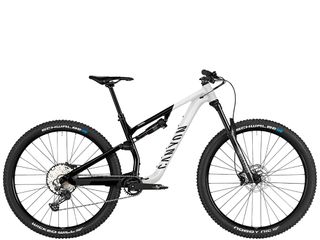
Best budget full-sus bike overall
Great ride quality and a well-thought-out spec for a reasonable price.
Read more below

Best shorter travel full-sus bike
A naturally fast and efficient full-sus bike with a great spec for the money.

Best all-round performer full-sus bike
Ready-to-rock full-suspension trail bike package with excellent geometry.
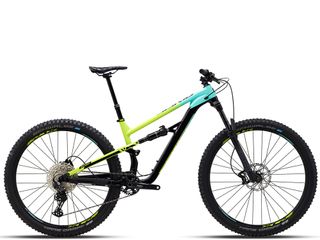
Best spec budget full-sus bike
High-quality trail bike with a seriously comprehensive spec.
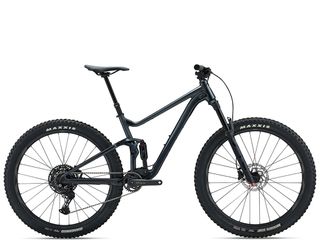
Best budget full-sus bike for flowy trails
Alloy flex-stay bike that's great for cruising flow trails.
R ead more b elow

Best confident handling full-sus bike
With a smooth four-bar suspension system that competes with much more expensive bikes.
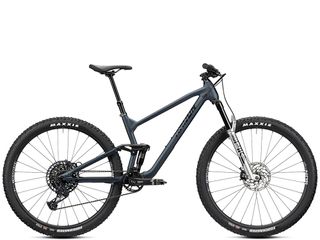
Best lighter weight budget full-sus bike
Lightweight, and excellent value spec from the German online bike brand.
Best budget full-suspension bikes
Why trust BikePerfect Our cycling experts have decades of testing experience. We'll always share our unbiased opinions on bikes and gear. Find out more about how we test.
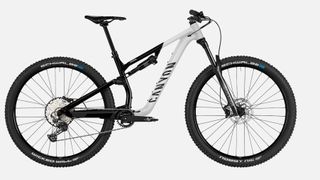
Canyon Neuron 5
Specifications, reasons to buy, reasons to avoid.
Canyon mountain bikes are well known for their incredible ride quality, so no matter whether you are paying top dollar or penny-pinching, you should expect a bike that has a dialed ride quality out on the trail. Canyon's top-of-the-range Neuron CF SLX 9.0 LTD really impressed us when we tested it and the Neuron 5 should have much the same suspension efficiency, lightweight and lively ride on twisting XC trails.
As is to be expected on a bike that is really pushing the boundaries of what 'budget' means, it's unsurprising that the Canyon Neuron 5 has one of the best specs out of all the bikes in this guide. Reliable suspension from RockShox, gearing from SRAM and braking by Shimano should see you through plenty of trail miles without fuss.
For more on the Neuron, see our Canyon Neuron 6 review – the next model up in the range.
Jamis Faultline A2
Our expert review:
Faultline A2 is the cheapest full-suspension 29er trail mountain bike from US brand Jamis. It follows the classic shock under top tube driven by a swing link design, matched to a pivot on the seat stay and a main pivot level with the chainring top. That means the rear wheel moves in a simple arc, but it’s a well balanced one.
The spec is impressively solid, dependable and recognizable brand name based. RockShox provides the 130mm Recon Silver RL fork and Deluxe Select R air-sprung rear damper. Transmission is 11-speed Shimano Deore including matching bottom bracket, through-axle crankset and 10-51 tooth wide range cassette. Brakes are Shimano too, but the entry-level M200 spec with a 160mm rear rotor. The hubs are also Shimano, laced to WTB 25mm rims fitted with tubeless ready WTB tires. Bar and stem are Race Face with a WTB Volt saddle on the KS dropper.
In our tests we found it gains speed easily for an economy option despite a near 16kg weight. The 760mm bar gives reasonable leverage through a head angle that’s appropriate for a trail all-rounder with 130/120mm travel. The Recon fork is consistently controlled and the toothy Vigilante front tire adds confidence in dry turns too. Add in the inherent reliability of the Shimano and RockShox kit, plus harder ‘Fast Rolling’ compound tires and it’s a good choice for high mileage riding on tamer trails.
For more details, check out our full Jamis Faultline A2 review .
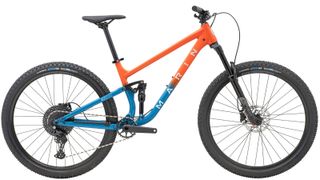
Marin Rift Zone 29 1
While most of the bikes here now have decent geometry, Marin’s Rift Zone bikes set the benchmark for bringing proper no-holds-barred rough play numbers to the affordable bike rankings. 65.5-degree head tube locks the front wheel into the terrain with a 35mm stem. A 77-degree seat angle still gives it attacking poise on climbs while the 430mm chainstays give a super responsive rear-end feel.
The 'Multitrac' frame gives 130mm of travel and while it comes with a 141mm QR rear it can be upgraded to a full 148mm width Boost bolted thru-axle. Suspension is taken care of by the Slide Boost RC fork with 140mm travel, and the X-Fusion O2 Pro R shock. Vee Tire dual compound Crown Gem tires are good all-round performers with broad tubeless-ready rims for stability and easy upgrading.
The gears are Shimano Deore 11-speed and the brakes Tektro HDM-280. You’ll need to pay more for the Rift Zone 2 to get a dropper post as standard, but overall value is good for a shop-bought, globally available bike.

Polygon Siskiu T7
The parent company of Polygon manufactures bikes and frames for a big list of other brands including some real premium names. Buying its own bikes gets you the same quality at a much lower price though and the Siskiu T7 is a thoroughly modern trail bike at a great price.
Here you get the option of 27.5-inch wheels in smaller frame sizes and then 29er on the bigger bikes. That gets you either 150mm forks and 140mm rear travel or 140mm fork and 135mm rear. Either way head angles are around 65-degrees with a 76.5-degree seat angle and a long 480mm reach on the large for excellent self-correcting stability. Super-short seat tubes keep the center of gravity low and you get long-stroke dropper seatposts as standard. You get a super-short 35mm stem for super-responsive steering with a RockShox Deluxe Plus Select shock and lightweight Recon RL fork. Add a 12-speed Shimano gearing mix and 2.4in wide Schwalbe Hans Dampf tires on wide tubeless-ready rims and you’ve got a seriously comprehensive spec for a total bargain price. Especially considering it comes from proper bike shops not just delivered in a box for you to build.
If you want a lighter, XC format then the Siskiu D7 and D5 deliver a slick-looking 120mm suspension performance, making Polygon a bargain bike powerhouse.

Giant Stance 29 2
While many of the best cross-country mountain bikes on the market are moving to flex-stay suspension designs, the reason for this is that by removing some pivots it saves weight and reduces the amount of things that need to be serviced. That said, Giant's budget Stance has been using its Flex Point design for years to create a rocker activated single-pivot system to deliver decent trail performance at a lower price.
The impressively low price is further aided by Giant's massive economies of scale and the fact that almost every component is also sourced in-house – even the forks are Giant's own design. The Suntour shock, Shimano drivetrain, cranks and brakes, and Maxxis tires are the exclusions to this. The only missing piece is a dropper post, although the frame does feature routing for an internally routed dropper post should you wish to add one yourself.
The decent selection of parts and quality frame production is paired with some fairly neutral geometry which will be best suited to cruising flow trails and new riders looking for fun rather than going full send through steep rock gardens.

GT Sensor Sport
GT's Sensor has been around for several years and uses a really well-executed take on a classic suspension layout rather than the unique designs of GT’s past. Combine the four-bar linkage with a large-volume X-Fusion 02 Pro RL trunnion shock and you’re getting a really smooth and neutral 130mm travel rear end that competes with much more expensive bikes.
The RockShox Recon Silver RL fork is usefully smooth too and while the skinny steel legs are heavy they are stiffer under load. You get a fully up to date 148x12mm Boost rear axle and the geometry can be set high or low. That gives a 65.5- or 66-degree head angle and 76- or 76.5-degree seat angle so the angles are totally on point for technical riding. The bottom bracket is still very high even in the low setting which can make it feel precarious rather than grounded. Reach is reasonable and you get a short stem and wide bar for control. The 10-speed MicroSHIFT gears work well, but the brakes are very wooden and numb. The WTB rims are relatively narrow too and the DNA compound WTB tires are better in the dry than the wet. You get a dropper post though which is a definite win.
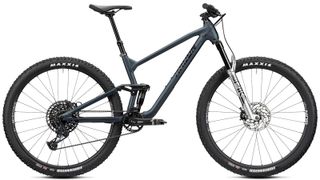
Radon Skeen Trail AL 8.0
German online bike brands are smashing the value-for-money comparison game these days and Radon reaches down lower on budget than Canyon or YT.
The Radon comes with the RockShox Pike Ultimate fork and RockShox Deluxe Select+ rear shock. As well as this you get mid-range SRAM NX/GX Expanded Eagle 12-speed gears, powerful Magura brakes, a proper post as standard and Maxxis Forecaster tires on quality Sun Ringle wheels. According to Radon that makes it just 14.35kg.
The only downside in what looks an unbeatable deal is that the frame is relatively old (it still has tabs for a front derailleur) and that’s reflected in the short and relatively steep geometry. If you’re not after slack and long then save your pennies and your effort on the climbs with the super-value Skeen.
How to choose the best budget full-suspension bikes
Does geometry matter.
The only thing you can’t upgrade on a mountain bike is the shape of it. Some manufacturers (not the ones featured here) just use old, outdated steep-and-short frames as the basis for their cheap bikes. Others make new frames but weirdly seem to think that the fresh riders likely to be buying at this price point would benefit from something that’s twitchy and sketchy rather than stable and confident.
As a rough guide, 120mm travel bikes should have a 67-degree head angle, moving towards 65-degree as travel extends to 150mm and you’re getting faster on descents. Reach figures should be 460+mm on a large, with a 50mm or shorter stem and a 760mm or wider bar for decent power steering.
What about suspension?
At the lower end of the price range, you’re almost certainly going to take a hit on suspension quality. That means 32mm steel legs rather than 35mm alloy legs on forks and simple rear shocks with limited adjustment and potentially less than perfect damping. You can expect to get equipment from Manitou, Suntour, X-Fusion or own-branded gear rather than RockShox or Marzocchi dampers although you can get them in this list. That doesn’t mean that cheaper forks and shocks etc can’t work well, but read our reviews to guide you in the right direction and potentially be more prepared to do more servicing and general TLC.
What components should I look for?
The real surprise with this list is how good the rest of the spec on several of these bikes is, with comparable brake and gear setups to hardtail bikes. The days of super long stems and narrow bars ruining the ride are thankfully behind us too and even saddles and grips are generally sorted. The thing you probably won’t get and will have to upgrade to is a dropper seat post but make sure that the frame you choose is at least ready for an internally routed setup.
Whether you get a hardtail or a suspension bike, swapping tires is a great way to make real performance gains at a reasonable price. So if you’re buying from a shop and have a bit of cash left in your budget then ask if they can swap them (or set the existing ones up tubeless) before you get the original ones dirty.
How much is a good full suspension bike?
It all depends on the type of trails you plan on riding, although almost all of the best budget full-suspension bikes focus on trail riding. Pricing starts at around $1,500 for a bike that is going to give decent performance on the trail. That said it can vary between different brands and the price points they choose.
The amount of extra kit and performance you get on the next bike up in the range – and the price gap – can alter significantly. In some cases, brand managers will sacrifice some profit to create a really killer value entry-level bike. In other cases, it’s you who’ll be making those sacrifices. It’s certainly always worth checking what saving a bit longer or digging deeper into your budget will get you and where relevant we’ve flagged up whether the ‘next bike up’ is the better deal here. If you can stretch your budget, check out our pick of the best mountain bikes under $2500 .
How we test the best budget full-suspension bikes
All the budget full-suspension bikes tested here have been ridden on a wide range of trails, from singletrack to technical woodsy riding, in a variety of weather conditions, from bone dry to properly sodden. We test bikes over a number of months so we can assess how they fare over time.
Meet the tester

Guy Kesteven is Bike Perfect’s tech editor. He spent a few years working in bike shops before starting writing and testing for bike mags in 1996. Since then he’s tested many hundreds of full-suspension mountain bikes.
Guy has been working on Bike Perfect since we launched in 2019. Hatched in Yorkshire he's been hardened by riding round it in all weathers since he was a kid. He spent a few years working in bike shops and warehouses before starting writing and testing for bike mags in 1996. Since then he’s written several million words about several thousand test bikes and a ridiculous amount of riding gear. To make sure he rarely sleeps and to fund his custom tandem habit, he’s also penned a handful of bike-related books and talks to a GoPro for YouTube, too.
Current rides: Cervelo ZFS-5, Forbidden Druid V2, Specialized Chisel, custom Nicolai enduro tandem, Landescape/Swallow custom gravel tandem
Height: 180cm
Weight: 69kg
Best mountain bike clipless pedals 2024 – the top-rated clipless MTB pedals for XC, trail and gravity riding
Best MTB saddles for comfort 2024 – 6 top-rated butt-pleasing perches for mountain biking and off-road cycling
McLaren (yes, the supercar brand) release an e-MTB which it claims to be the world’s most powerful street-legal electric mountain bike
Most Popular
Best down-country mountain bike: short travel shredders
- Danny Milner
- January 10, 2024
Short on travel but big on geometry, we review the best down-country mountain bike rigs – fleet-footed steeds that blend the speed of an XC bike with the capability of trail bike.

Trek Top Fuel 8 Credit: Roo Fowler
Short on travel, light on weight, but big on geometry, the best down-country mountain bike rippers give you everything you want and nothing you don’t. Fast and fun, in a lightweight, efficient package, these bikes can cover ground with minimal fuss and still be thrashed to within an inch of their lives on proper trails.
- Best mountain bikes: hardtail, XC, trail and enduro to suit all budgets
- Best cross-country XC mountain bikes
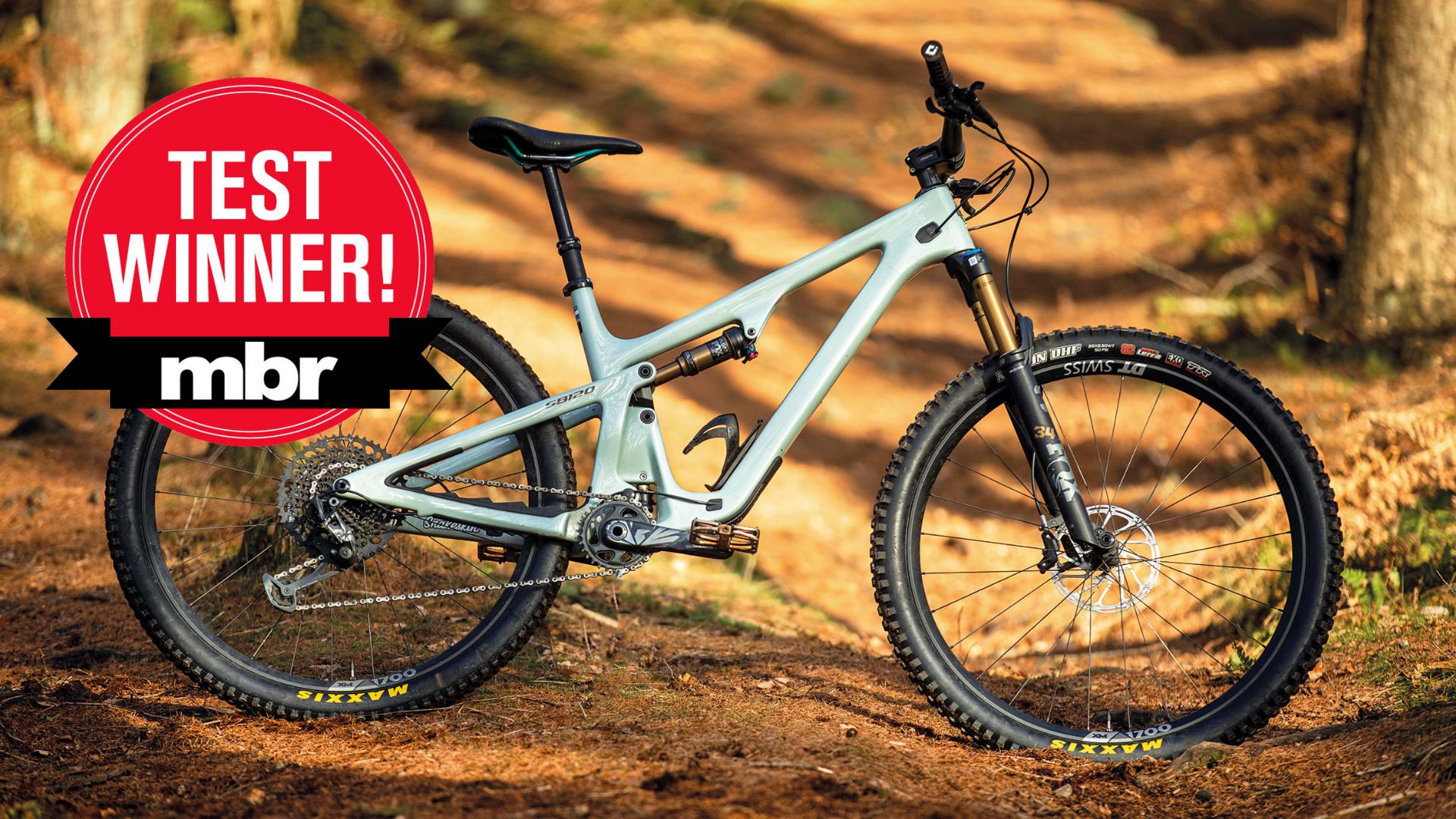
The Yeti SB120 is a down-country bike you can buy with your head as well as your heart
1. Yeti SB120
The best down-country bike if money is no object.
Wheel size: 29in | Frame: Turq carbon, 120mm | Sizes: XS, S, M, L, XL | Weight: 13.3kg (29.3lb) | Rating: 9/10
Reasons to buy:
- All round overachiever with superlative suspension
- Wide size range
Reasons to avoid:
- Agile rather than ultra aggressive
- Not actually that light
- No internal storage
From one of the most aspirational brands in the business comes the impeccable SB120. Yeti shrinks and shoehorns its unique Switch Infinity suspension design into the SB120 chassis. Where the swingarm moves up and down on dual Fox shafts just above the bottom bracket. And the new design has improved seals, bearings, hardware, and pivots, so it should stay in tip-top condition for longer.
And this clever suspension design really works. As we explained in our review, “the supple suspension is stable under power gives a really positive pedalling feel”. Then, when you really hit a something hard and the rear wheel sticks to the ground, giving superb traction and control. It needs a lighter set of wheels to do the flickable geometry and sublime suspension justice, but even out of the box the Yeti SB120 had us smitten.
Read our full review of the Yeti SB120

Santa Cruz’s Tallboy is a terrier that thinks it’s a rottweiler
2. Santa Cruz Tallboy
Best down-country bike for sending it.
Wheel size: 29in | Frame: Carbon CC, 120mm | Sizes: XS, S, M, L, XL, XXL | Weight: 13.08kg (28.84lb) | Rating: 9/10
- Outstandingly fast and focused full-send aggression
- Does things normally reserved for burlier bikes
- Superb size range
- Internal storage compartment
- Needs a pretty skilled rider to avoid pratfalls
- Uncomfortably uncooperative on technical off-piste trails
- Can be tiring to ride
Although often overlooked in the comprehensive, verging on confusing, Santa Cruz range, we think the Tallboy is an undiscovered gem. You’ve heard of small man syndrome, or small dog syndrome, well the Tallboy has small bike syndrome, where it steadfastly believes it’s actually an enduro bike, and deserves to be ridden as such. The stiff frame and aggressive angles beg to be wrung out on every descent, yet the efficient suspension and lightweight mean it’s always the first bike back up to the top of the hill.
For some riders, all that straining at the leash might be too much. But if you love wringing the neck of a short travel whip, and seeing your buddies slack-jawed in amazement as you undermine and overtake their big-travel enduro bikes, the Tallboy is the ultimate sleeper bike.
Read our full review of the Santa Cruz Tallboy

Transition’s Spur is still one of the finest down-country bikes we’ve ever tested
3. Transition Spur
Best lightweight down-country bike.
Wheel size: 29in | Frame: Carbon, 120mm travel | Sizes: S, M, L, XL | Weight: 11.25kg (24.8lb) | Rating: 10/10
- Perfect blend of speed and control
- Lightweight
- Not the most robust build if you’re carrying some timber
- Narrow size range
The Transition Spur is arguably the bike that spawned the down-country category, and also the bike that perhaps best defines it. At under 11.5kg, the Spur flies out of the gate, haring up climbs and tearing along high-speed singletrack. That lack of inertia encouraged us to sprint every rise, pop every jump, and schralp every turn, helped by the stable geometry and supple suspension.
With lightweight RockShox Sid forks up front, the temptation is to add travel and girth, but to do so is to dilute the Spur’s potency and add unnecessary grams. So while there’s a bit of flex when pushed hard, we’d treat that as part of the charm, and lap up the whirlwind of action that accompanies every descent. As we said in our review, the Transition Spur is “the best-realised ‘down-country’ bike we’ve ever tested and the one we all covet if we were spending our own cash”.
Read our full test review of the Transition Spur

Trek’s Top Fuel 8 offers a high-octane ride
6. Trek Top Fuel
Explosive trail weapon.
Wheel size: 29in | Frame: Carbon or alloy, 120mm travel | Frame sizes: S, M, M/L, L, XL, XXL | Weight: 14.89kg | Suspension travel: 130mm f/120mm r | Rating: 9/10
- Poppy, playful and efficient
- Available in six frame sizes
- Internal down tube storage
- Mino Link flip chip allows geometry tweaks
- Needs a 180mm rear rotor
- Accurate rear shock set up is crucial
- A solid build, so not the lightest in its class
While the Trek Top Fuel used to be a lean, mean, cross-country fighting machine, the middle-aged spread has left it sagging a little on the scales. But don’t let that fact put you off, because the ride quality is worth its weight in gold, even if it won’t be competing for gold medals on the race track.
In our test we praised the Top Fuel as offering a “fast, fun and engaging ride”. Where “Its poppy playful nature, combined with generous sizing, means you never feel limited by the travel for regular trail riding”. Combined, this means the Trek Top Fuel provides a high-octane ride that keeps the pace high without compromising on fun. If you can stretch to one of the carbon options, that will help shed some weight, and really light the blue touch paper.
Read our full test review of the Trek Top Fuel 8

The Canyon Neuron 6 is fast and frugal
7. Canyon Neuron 5
Speed freak that also enjoys a party.
Wheel size: 27.5in or 29in | Travel: 130mm | Frame sizes: XS, S, M, L, XL | Frame: Aluminium or carbon | Weight: 14.63kg (32.25lb) | Rating: N/A
- Friendly yet rewarding geometry
- Excellent value
- Seat tube could be a bit shorter
- Saddle is a bit too racy
- Not that light for a down-country bike
The Neuron is Canyon’s back-to-basics trail bike, newly updated for 2023, There are four carbon and four alloy models to choose from, with prices starting from £1,849 for the Neuron 5 and going up to £5,749 for the Neuron CF LTD. There’s also a kids’ Young Hero model with an XS frame and 27.5in wheels for £1,499, and women’s versions of the Neuron 6, Neuron 7 and Neuron CF8 available at no extra cost.
As with the previous bike, all XS and S frames come with 27.5in wheels, while the Medium upwards come with 29in wheels. As with most Canyons, you’ll need to factor in a bike box at £18.99 and delivery at £37.99 to all of the headline prices. Whichever you choose, the latest Neuron is versatile, affordable and a total blast to ride, as happy hitting enduro tracks and sending jumps as racking up the miles on a multi-day ride. The alloy frame has a comfortable, compliant ride that’s never jarring, and the choice of fast-rolling Schwalbe tyres means it rolls along almost effortlessly.
Read our full test review of the Canyon Neuron 6

Looks so sharp you could cut yourself just looking at it: The YT Izzo Uncaged 7
Rapier-sharp speed and agility
Wheel size: 29in | Frame: Carbon, 120mm travel | Frame sizes: S, M, L, XL, XXL | Weight: 11.4kg | Rating: N/A
- Acutely responsive and ruthlessly efficient
- Agile and accurate
- Good spec for the price
- Nowhere to hide in the rough
- Traction/grip is not the best
- Doesn’t really need the remote lockout
- Front tyre could be more aggressive
YT’s razor-sharp Izzo feels a million miles away from the brand’s signature Capra and popular Jeffsy trail bike. It’s blisteringly fast but ruthlessly unforgiving, so you need to be on top of your game and fighting fit to keep it under control and take the punches. It’s much stiffer than the Transition Spur, and not as capable as the Santa Cruz Tallboy or Yeti SB120, so in some ways it’s a bit of an anomaly. But it’s also a great-looking bike, feels amazing in certain situations, and the fact that it’s a challenge to get the most out of will definitely appeal to a certain type of rider.
Read our full test review of the YT Izzo Uncaged 7

Orange knows how to build a great handling bike, and the Stage Evo is no exception

9. Orange Stage Evo
Packs big bike geometry into a nimble 120mm package.
Wheel size: 29in | Frame: 6061-T6 Aluminium, 120mm travel | Frame sizes: S, M, L, XL | Weight: 13.83kg (30.49lb) | Rating: N/A
- Incredibly well-poised handling belies its modest weight
- It’s arguably a trail bike
Orange may have ploughed its own furrow over the years, towed by a horse rather than a GPS-guided John Deere, but despite the UK-brand’s traditional frame materials and construction methods, it continues to bang out bikes that ride every bit as well as more cutting-edge rivals. Often even better. The Stage Evo is one such bike, and effectively a shrunken Stage trail bike. And from the very first corner we were reminded why Orange still commands a loyal customer base – the Stage Evo simply shreds. When we tested it, we noted “yes, it’s easy to ride beyond the physical limits of the travel, but that’s what makes the Stage Evo such an engaging bike on regular terrain”.
Read our first ride review of Orange Stage Evo

As soon as you release the reins, the Spur starts to gallop
What is a down-country mountain bike?
A few rules to help categorise a down-country bike. The first rule is that these rules are made to be broken!
Nothing over 120mm
No more than 120mm of suspension travel at either end. The archetypal down-country bike should have closer to 100mm of rear travel. And if there’s a 130mm travel fork up front, it’s ruled out. Usually. There are some outliers than we allow into the down-country fold. Otherwise the whole thing just gets far too close to a regular trail bike. So, no Norco Optic or Nukeproof Reactor 290c ST. Too trail-bikey.
Having said that, neither rear travel nor fork travel should have less than 100mm. Save that for XC race bikes.

With less mass to manhandle, down-country bikes like the YT Izzo goad you into throwing shapes at every opportunity.
Nothing steeper than 67°
We’re talking head angles here. Non-XC geometry is the key thing that must be included if a bike is to be classed as down-country. And though we say ‘geometry’ we really mean head angle. There’s currently not much consensus about the other angles and measurements on down-country mountain bikes; they don’t all have longer reach numbers, nor steeper seat angles, nor super low BBs.
But the head angle on all down-country bikes cannot be steeper than 67°. 66° is arguably the most commonly seen number.
Big wheels only
You’ll not find any 27.5in wheels here. Nope, not even just on the rear as a modern mullet setup. 29in wheels rule the down-country roost.

Although it doesn’t have the poppiest suspension feel, the Tallboy is great fun on jump trails
What’s the difference between an XC bike and a down-country bike?
That’s a contentious one, and mostly a matter of opinion. But in our view, a down-country bike is a trail bike with the weight and travel of an XC bike, whereas an XC bike generally has steeper geometry, a lower front end and a stronger bias towards efficiency. Using, for instance, remote lockouts to maximise power transfer on smooth surfaces. The lines are blurred, however, and some XC bikes are closer to down-country bikes than others. And the components used also make defining bikes more difficult. Some down-country forks have all-out XC race forks. Some have middling 34-35mm stanchions. Some have four-pot brakes and huge rotors. Others just have 180/160 twin-pot combos. Some have dinky stems. Some still sport stems over 50mm long.

True XC bikes, like the Specialized S-Works Epic WC, are lighter, pricier, and more focussed machines.
It’s the finishing kit that is perhaps key to the down-country experience. And expectation. Some down-country bikes appear to be aimed at ex-XC lycra-heads looking for more fun and less sketch in their rides. Other down-country bikes are aimed at the all-out aggro brigade who have tired of their super-capable enduro bikes and wish to inject a level of limit to their Sunday shredding.
In our opinion, it’s the latter type of down-country bike that is most interesting and exciting. But more capable XC bikes also provide unique thrills, and that injection of effortless pace never gets boring.
Slacker, longer, lower… shorter. Bring it on.

- Mountain Bikes
- Gravel Bikes
- Hybrid Bikes
- Electric Bikes
- Commuter Bikes
- Exercise Bikes
- Women’s Bikes
- Kids’ Bikes
- All Best Bike Brands
- Mountain Bike Brands
- Electric Bike Brands
- Bike Rack Brands
- Brand Review: Rad Power Bikes
- Brand Review: Ride1UP Bikes
Disclaimer: Bikexchange is reader-supported . We may earn an affiliate commission when you buy through the links on our site.
Cannondale Habit Series Overview

The Cannondale Habit is a bike that you should approach with caution, as it may result in a serious addiction – to fun!
Aptly named, this adventure-packed trail bike is known to cause habitual trips into the mountains for days on end. Whether you love charging down dirt tracks at speed or snaking along rocky mountain trails, the Habit will happily feed your addiction.
- Tires : 29×2.5″ & 29×2.4″
- Head Tube Angle : 66° / Seat Tube Angle : 74.5° / Chainstay : 435mm
- Travel : 140mm front, 130mm rear
Why Choose Cannondale?
Cannondale has produced a variety of Habit mountain bikes to suit all needs, including an e-bike, a women’s specific version, and a structured pricing system to suit beginners, intermediates, and pros. From the full-carbon, tricked-out Habit 1 down to the tough and ready alloy Habit 5, there’s something for everyone, no matter your budget.
The Cannondale Habit range combines quality materials like SmartForm alloy and BallisTec carbon frames with carefully selected components, including SRAM or Shimano drivetrains, Maxxis tires, and Fox Performance or RockShox shocks.
All bikes come with hydraulic disc brakes, dropper seat posts, 29” Stans NoTubes rims, and quality Cannondale finishings to provide the best results at an affordable price.
Full-Suspension Mountain Bikes by Cannondale
- Jekyll – 29″ / HT: 65° / ST: 75° / Chainstay: 442mm / Travel: 150mm, 150mm
- Habit – 29″ / HT: 66 / ST: 74.5 / Chainstay: 435mm / Travel: 140mm, 130mm
- Scalpel – 29″ / HT: 67° / ST: 74 ° / Chainstay: 436mm / Travel: 120mm, 120mm
Hardtail Mountain Bikes by Cannondale
- Trail – 29″ / HT: 66.5° / ST: 72.6° / Chainstay: 435mm / Travel: 75mm – 120mm
- F-Si – 29″ / HT: 69° / ST: 73.1° / Chainstay: 427mm / Travel: 100mm
Table of Contents
Habit Men’s
Habit Women’s
Habit Electric
Size Charts
Cannondale Habit Men’s Bikes
Cannondale habit se.
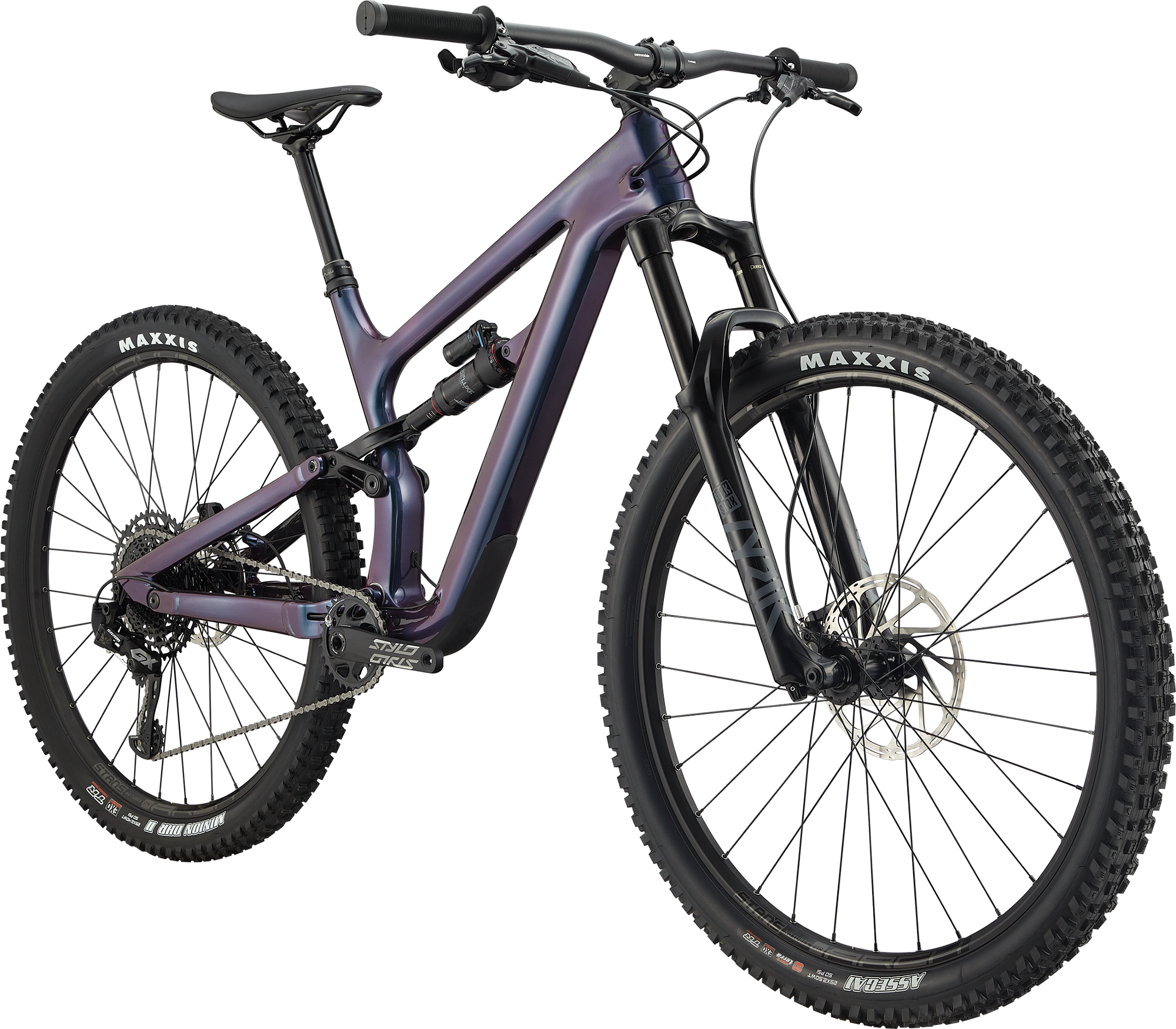
MSRP $4,750
- Fork: RockShox Lyrik Select Plus, 140mm travel
- Rear Shock: RockShox Super Deluxe Select Plus RT, 130mm travel
- SRAM Code R Hydraulic Disc Brakes – 200/180mm rotors
- DownLow dropper post
Cannondale Habit 1

MSRP $4,200
- 12-Speed Shimano XTR drivetrain
- 29×2.5″ on the front, 29×2.3″ in the rear
- Fork: RockShox Pike Ultimate RC2, 140mm
- Shock: RockShox Super Deluxe Ultimate RCT, 130mm
- Cannondale C1 Carbon Handlebar
- Downlow dropper seat post
- Shimano XTR Trail, 4-piston Hydraulic Disc Brakes w 180mm RT900 rotors
Cannondale Habit 2
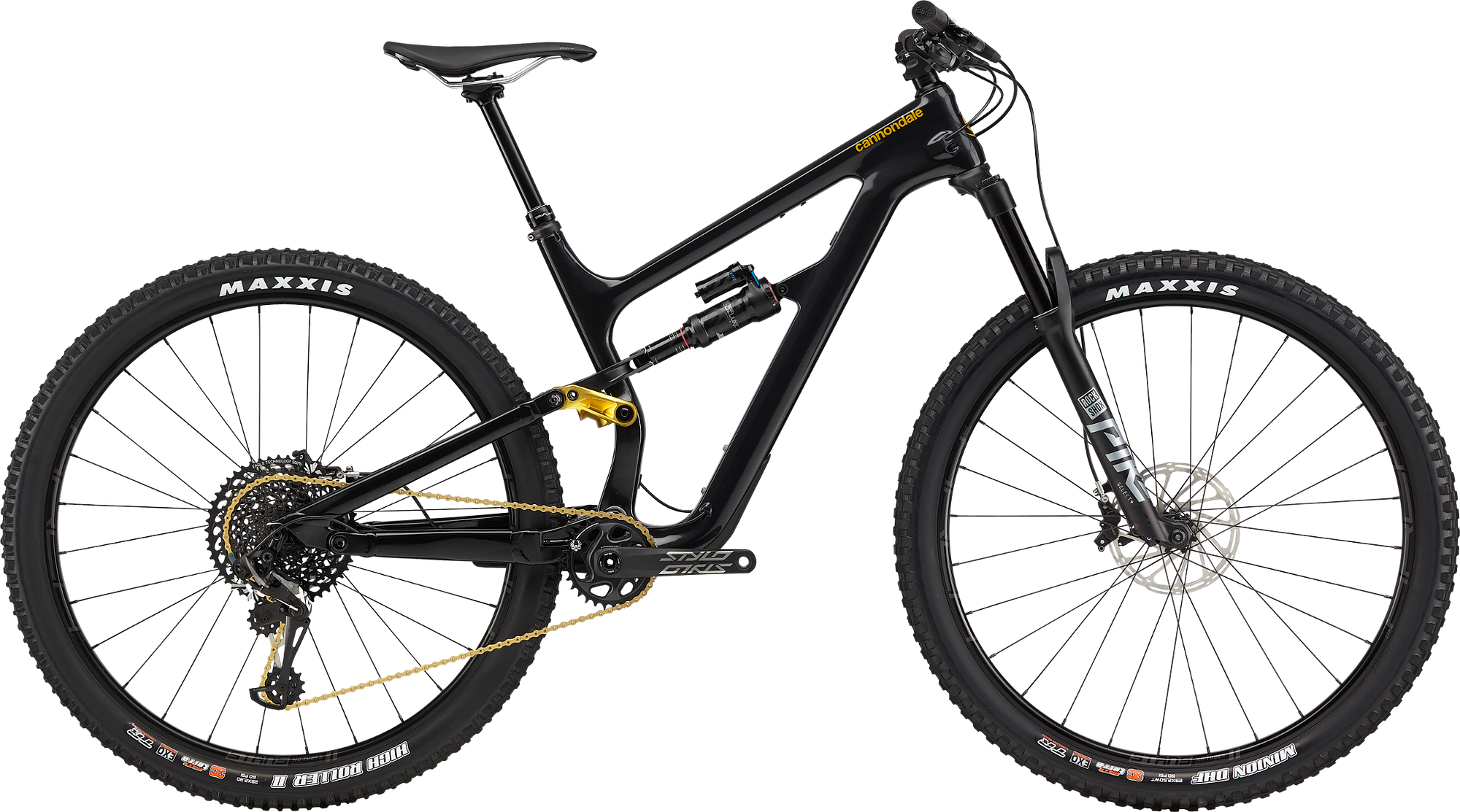
MSRP $5,250
- 12-Speed SRAM X01/GX Eagle
- Fork: RockShox Pike Select Plus R, 140mm travel
- Rear Shock: RockShox Super Deluxe RCT, 130mm travel
- Stan’s NoTubes ARCH MK3 rims, 29×2.5″, 29×2.3″ tires
- SRAM G2 RSC Hydraulic disc brakes, 180mm Centerline rotors
Cannondale Habit 3

The Habit 3 is a full-suspension trail bike with a fun, agile feel. The lightweight BallisTec carbon frame is kitted out with a C1 alloy four-bar suspension system that links to a pivot near the top of the chainring and a shock connected to the down tube. The old-school frame geometry is designed to achieve a flat-out speed over rocky terrain – and it does this with outstanding results!
Riders can switch the suspension to ‘Climb Mode’ when heading uphill to get better traction out of the 130mm of travel on the Fox Float Performance rear shock. For tight and agile descents, the 140mm travel Fox fork will keep you steady and the grippy Maxxis Minion 2.5” tires offer excellent traction.
- 12-Speed SRAM SX/GX Eagle
- SRAM Guide R Hydraulic Disc brakes, 180mm rotors
- Fork: Fox Float Performance 34, 140mm travel
- Fox Float Performance DPS Evol, 130mm travel
- 29×2.5″ / 29×2.3″ tires
Cannondale Habit 4

MSRP $3,250
- 12-speed SRAM SX Eagle
- RockShox 35 Gold RL, 140mm
- RockShox Deluxe Select+, 130mm
- Shimano MT200 Hydraulic Disc Brakes w/ 180mm rotors
Cannondale Habit 5
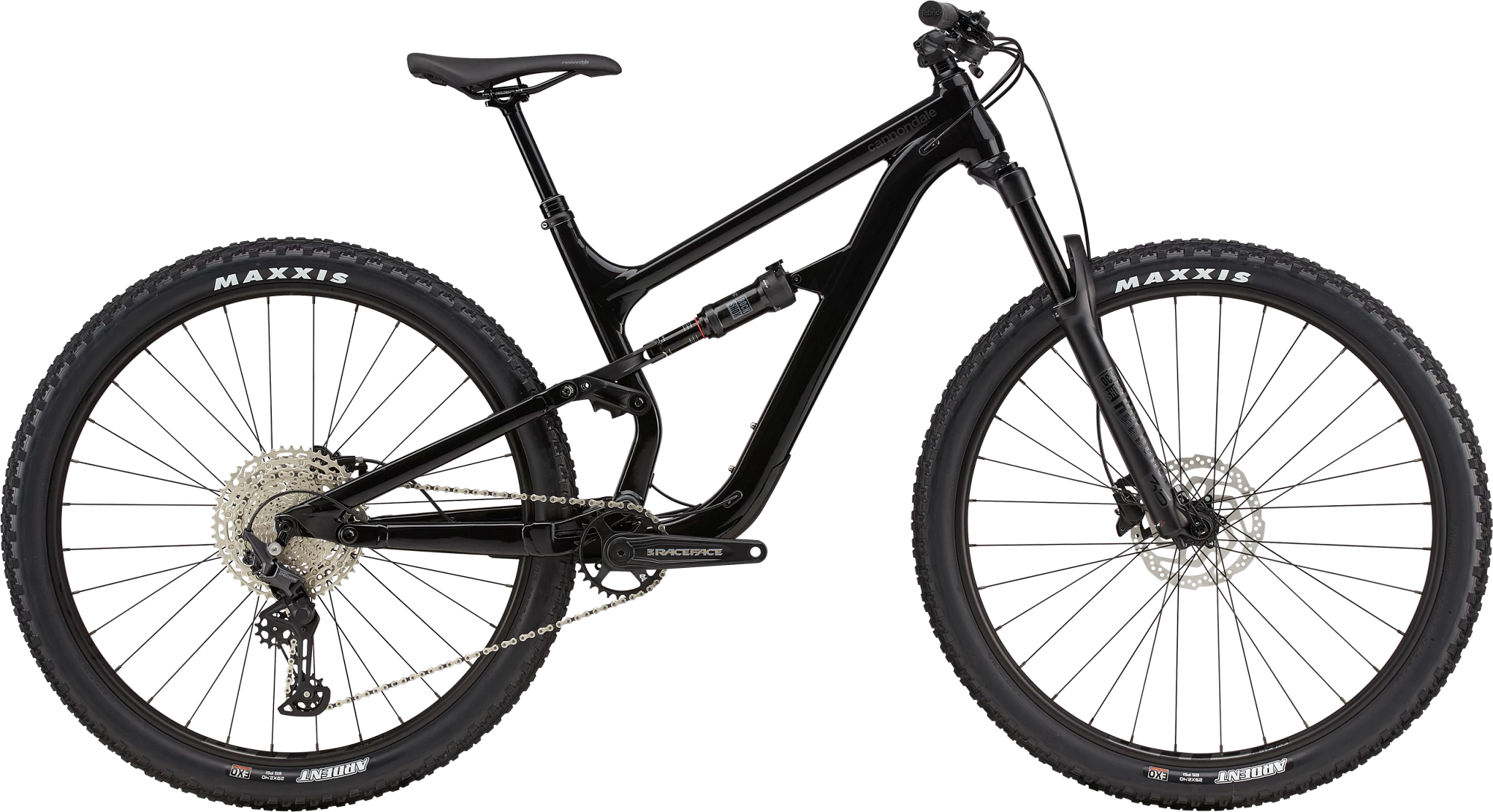
MSRP $2,700
With shorter stays, a slack head angle, and a steep seat angle, the Habit 5 is a full-suspension MTB with an aggressive attitude. Take it down the mountain at speed or flatten out bumpy backcountry trails with the excellent Proportional Response technology. The ability to adjust the suspension by size means you’ll get perfect traction and control at all times, no matter who is riding.
- RockShox 35 Silver R coil, 140mm
- RockShox Deluxe Select shock
- Drivetrain : 11-speed, Shimano Deore M5100
- 29×2.4″ & 29×2.5″
- Tektro M275 hydraulic disc brakes, 180/180mm rotors
With the reversible Flip Chip, you can easily adjust the geometry or swap between 29” and 27.5” wheels, while an Ai Offset drivetrain provides greater tire clearance for those seriously tough conditions. The C1 alloy frame makes the Habit 5 a bit heavy, but they balance this out with the excellent rear suspension performance. An 11-speed Shimano Deore groupset provides smooth shifting while upfront you get a RockShox 35 fork with 140mm of travel.
- Also featured in: Best Full-Suspension Mountain Bikes Under $3,000
Cannondale Habit Waves
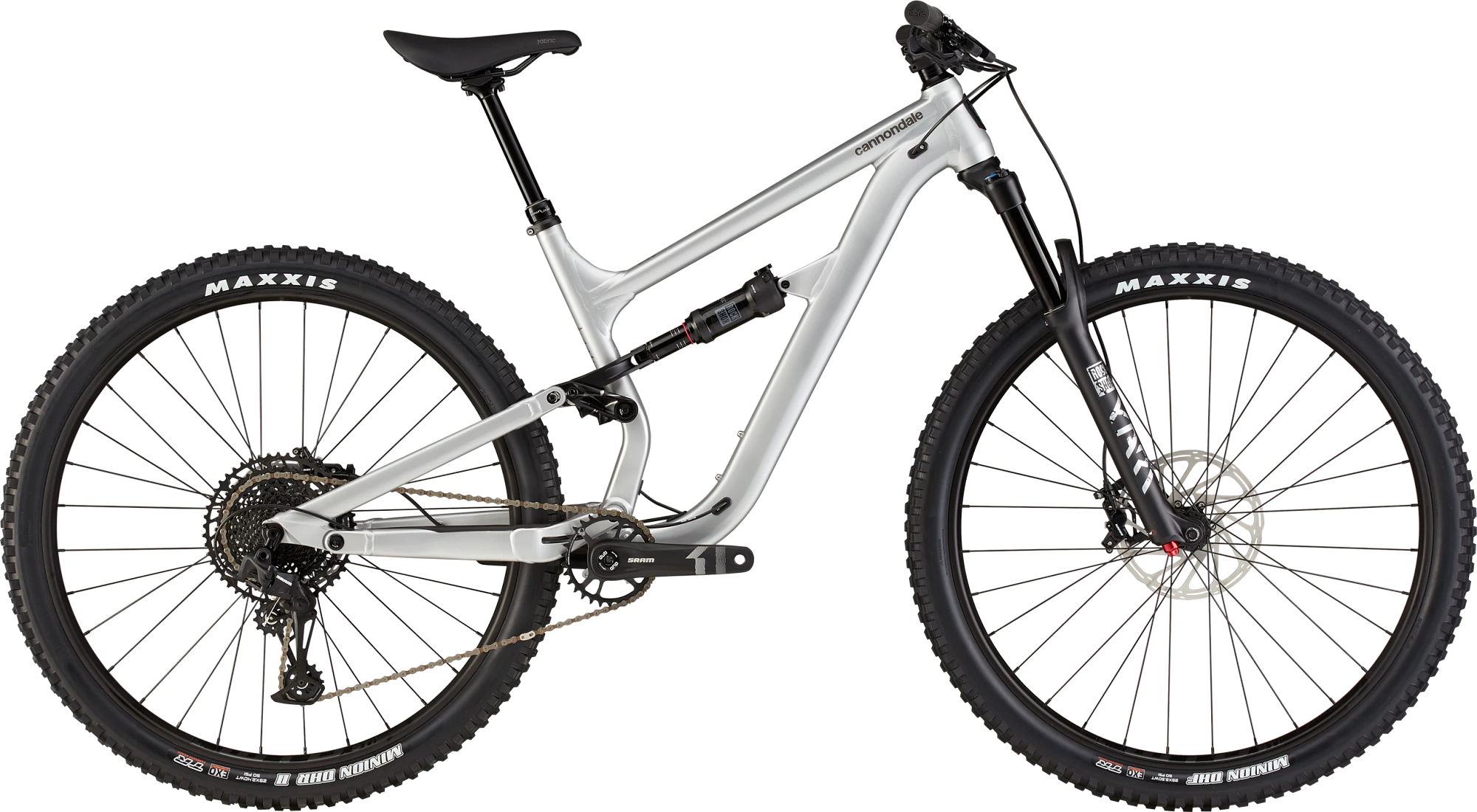
The Habit Waves is a playful aluminum trail bike from Cannondale, featuring RockShox dual-suspension and a 12-speed SRAM SX Eagle drivetrain. The tubeless-ready WTB STi29 rims have been fitted with thick-treaded 2.5” Maxxis Minion tires – great for attacking steep ascents!
With 140mm of front travel and 130mm rear, the Habit Waves floats over hazards and obstacles with ease and charges down trails with speed. Admittedly, the 6061 aluminum frame isn’t the lightest on the market, but it’s tough and ready to take on the mountains. As an introductory full-suspension MTB, it offers excellent value for money.
- 140mm f, RockShox Jari
- 130mm r, RockShox Deluxe Select
- SRAM G2 R Hydraulic disc brakes – 200/180mm rotors
- 29×2.5″ / 29×2.4″
Cannondale Habit Women’s Models
Cannondale habit 1 women’s.
This female-specific MTB from Cannondale features a highly versatile carbon frame with top-notch components and weight-responsive suspension. It features quality parts like the 12-speed SRAM Eagle NX drivetrain and matching Guide R hydraulic disc brakes with Stan’s NoTubes rims and Maxxis Minion tires.
The BallisTec carbon front triangle is complemented by a SmartForm C1 alloy swingarm that provides 130mm of rear travel on a Fox Float Performance DPS EVOL shock. Up front you get a Fox Float Performance 34 fork with 140mm of travel, providing an ideal balance of rigid upward traction and comfortable downhill absorption. The combination results in a killer trail bike that can tackle any kind of terrain with ease.
- Shock: Fox Float Performance DPS EVOL, 130mm travel
- Stan’s NoTubes ARCH S1 rims
- 12-Speed SRAM GX/NX Eagle
- DownLow dropper seat post
- Tires: 29×2.5″ front, 29×2.3″ rear
- Est. weight: 31.5lbs
More for women:
- Habit 2 Carbon Women’s
- Habit 3 Women’s
- Habit 4 Women’s
- Habit 5 Women’s
Cannondale Habit NEO – Electric bikes
Habit neo 1.
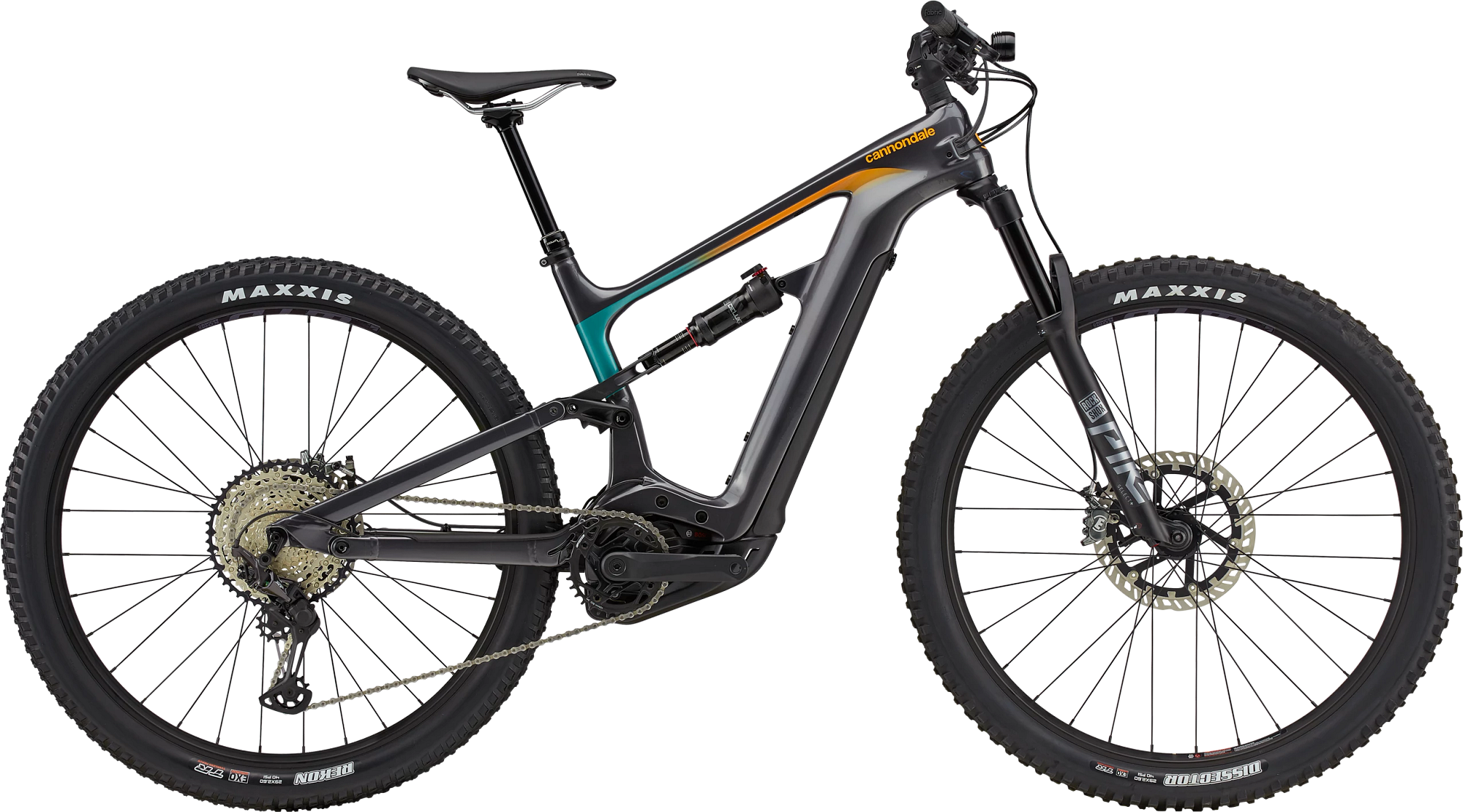
- 12-Speed Shimano XT
- Fork: 140mm RockShox Pike
- Shock: RockShox Deluxe Select+ RT, 130mm travel
- Magura MT5 Hydraulic Disc Brakes, 220/203mm MDR-Rotors
- 29×2.6″ Maxxis Dissector/Rekon
ELECTRONICS
- Bosch Performance Line CX – Kiox color display
- 625Wh Bosch Powertube battery
- Range up to 67mi (108km)
Habit NEO 2
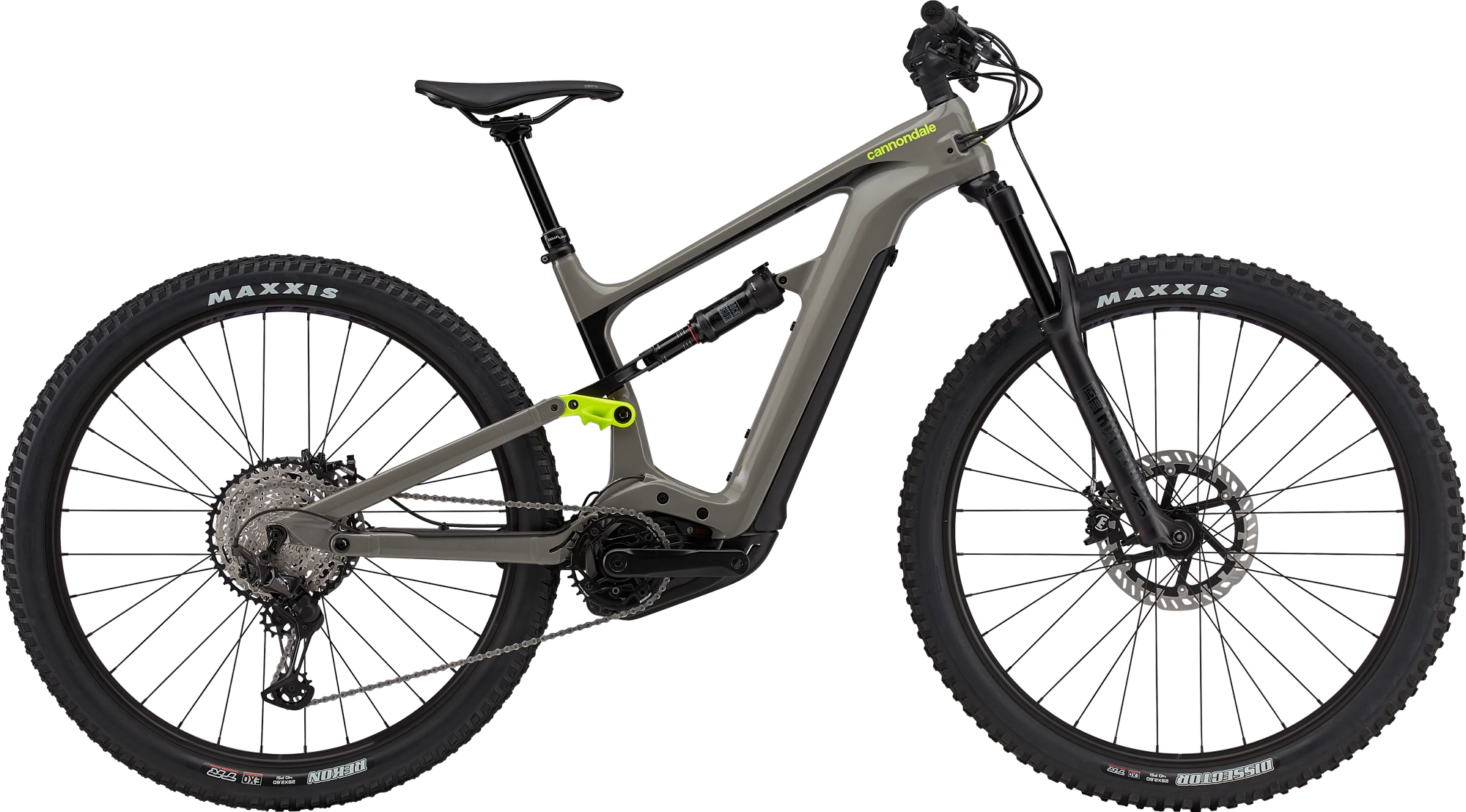
Let’s be honest – for most people, cycling up steep, rocky ascents is not a fun day out. The old days of “no pain, no gain” is gone – it’s time for all the gain without the pain! Introducing the Cannondale Habit Neo 2, a full suspension electric trail bike that takes the sweat out of a full day of downhill charging.
- 12-Speed Shimano SLX
- Fork: RockShox 35 Gold RL, 140mm travel
With explosive pedal-assistance provided by a Bosch Performance CX motor and Shimano SLX drive unit, you’ll float up those rocky mountain passes with ease. Coming down is just as fun with the Proportional Response rear suspension – tailored to provide optimal traction, suppleness, and control. It’s power up and powers down in equal measures, you just provide the passion.
Cannondale Habit NEO 3
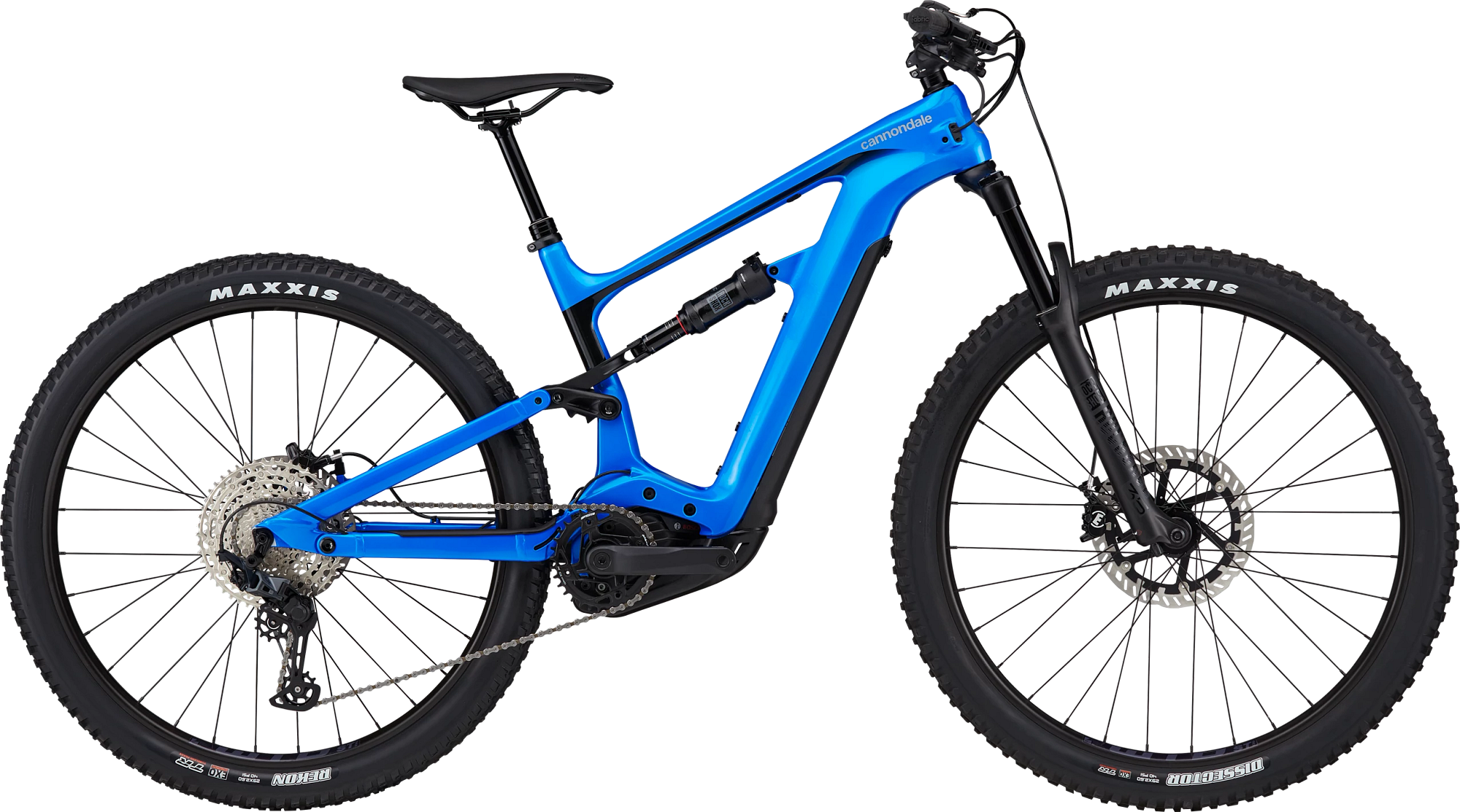
- 12-Speed Shimano SLX/Deore
- Shock: RockShox Deluxe Select R, 130mm travel
- Magura MTThirt Hydraulic 4-piston disc brakes w/ 220/203mm rotors
Cannondale Habit NEO 4

- Drivetrain : 12-Speed Shimano Deore
- Fork: RockShox Recon Silver RL
- Shock: RockShox Deluxe Select R, Debonair
- Brakes: TRP Slate G4, 4-Piston Hydraulic Disc Brakes, 200mm rotors
- Bosch PowerTube 500Wh Battery
- Bosch Purion Display
NEO 4+comes with a slightly larger battery
Bosch Performance Line CX drive unit, 625Wh battery with a range up to 48miles (78km)
Cannondale Habit Size Charts
Where to buy cannondale habit online.
Buy on REI Buy on Gravity Coalition
Share this on:
About the Author

Sam Millers
Leave a reply cancel reply.
Your email address will not be published. Required fields are marked *

2024 BUDGET BIKE ROUNDUP
Trek fuel ex 5 gen 5 review.
Words by Travis Reill | Photos by Dusten Ryen & Brian Niles Sponsored by Leatt & Tifosi Optics
With trail bikes in Trek’s lineup reaching five-digit prices, it is nice to see the industry giant offer a full-suspension trail bike that doesn’t break the bank. Trek was kind enough to send us the Fuel EX 5 to ride and review in our budget-bike shoot-out. At just under $2,500, the Fuel EX 5 is one of the most expensive bikes on test. We were excited to get the Fuel EX 5 out on the trails and see how it stacks up against the others in our test bike group.
• 130mm single-pivot ABP • Flip-chip adjustable geo • HTA 66.5 (high setting) • STA 75.5 (high setting) • REACH 475 (Large, high setting)
Big-brand Security
Highest Quality Frame On Test
WE DON’T
Short dropper post
Wide, Heavy wheels
Least Pedaling Support Of The Group
ABOUT THE TREK FUEL EX 5
Many of us are familiar with Trek’s trail-busting Fuel EX line. The Gen 6 Fuel EX saw added travel – not to mention a new frame design – but that doesn’t mean there isn’t room for the shorter-travel younger sibling out on the trails. With 140/130mm of travel and relatively moderate geometry, the Trek Fuel Gen 5 has been a trail bike many have reached for years.
FRAME AND FEATURES
Trek’s Fuel EX 5 features Alpha Platinum Aluminum. Trek boasts their aluminum “is continuously cold extruded and butted at multiple points, and hydroformed into sophisticated tube shapes for maximum strength and minimum weight.” The Fuel EX also has Trek’s Knock Block headset system, which prevents the handlebars from hitting the top tube and causing damage in a crash. Cables are internally routed, and the frame is offered in two color options: black, or the black and yellow we received.
The Fuel EX is offered in seven sizes, from XS to XL. X-small and small frame sizes come with 27.5-inch wheels and a pronounced dip in the top tube to help with standover height. Sizes medium and up are all equipped with 29-inch wheels. If you are familiar with Trek’s sizing, you will know that they also offer a medium/large size for those in between the two sizes. This is the only “in-between” size offered.
Trek’s Mino Link allows you to change the Fuel EX’s geometry. Switching from high to low will slacken the bike by 0.5°, drop the BB by 6mm, and shorten the reach by 5mm. While the bike comes with a 140mm travel fork, Trek gives allowance for bumping up to 150mm to improve descending capability.
The Fuel EX is essentially a linkage-driven single-pivot with one key difference—a pivot at the rear axle. Trek calls this their Active Braking Pivot (ABP) design. On most suspension designs, braking is considered to negatively impact the rear suspension’s ability to absorb impacts and provide traction. Trek’s ABP design aims to allow the rear suspension to remain more active under braking forces.
The Fuel EX 5’s geometry remains relatively moderate compared to today’s trail bike trends. For clarity’s sake, I’ll share the geometry in the “high” setting of the geometry-adjusting Flip Chip. The head tube angle is 66.5° and is paired with a 75.5° seat tube angle. The Stack Height ranges from 559mm to 623mm and Reach lengths range from 400mm to 500mm. Our size large came in at 609mm and 475mm respectively..
The BB height is 341mm in X-small and small, then 346mm for medium and up. Similarly, the BB drop is only 14mm below the axles on the two smallest sizes, and 28mm on sizes medium and up to account for the larger wheels. 436mm chainstays feature across all sizes. Our size Large Wheelbase totalled 1211mm.
BUILD SPECS
For the Fuel EX 5, Trek only offers two build options: a higher-end, 9.8 AXS Gen 5 and the budget-friendly EX 5 they sent us at $2,499. Leading the charge on our test bike was a Rockshox Recon Silver with the Motion Control damper and lockout. In the rear, there was a X-Fusion Pro 2 shock with “open” and “climb” positions.
The drivetrain is a complete Shimano Deore M6100 12-speed build, with Shimano’s 10-51 tooth cassette and a 30-tooth chainring. Shimano also handles the brakes, with 2-caliper hydraulic stoppers and 180mm rotors. 35mm width Alex MD35 wheels are laced to Bontrager hubs, and roll on wide 2.6 Maxxis Rekons. Bontrager makes up the rest of the build with tires, cockpit, and saddle—with the exception of a TranzX dropper post at a short 130mm drop length.
With a brand name as large as Trek, our expectations with the Fuel EX 5 were reasonably high. Even with a more budget-friendly component build, we figured Trek’s proven platform would shine through, regardless of the parts hanging from the frame.
When we tested the Trek Fuel EX 5 on the trails, we found it best suited for riders looking to put in miles. Its very moderate 66.5° headtube angle—the steepest of any of the bikes on test—puts the rider’s body more toward the front of the bike. This allows for a comfortable pedaling position, especially on climbs, which the Fuel EX 5 did reasonably well on. That forward-heavy position also provided good handling on the relatively techy bits of the climbs.
Even with a steeper headtube angle, the Fuel EX 5 wasn’t overly twitchy on faster descents. With 130mm of rear travel, it tackled some rough and chunky trails reasonably well, but finding its limit was quite easy for our aggressive riding crew. It also jumped decently, although the suspension had been firmed up quite a bit. This was done out of necessity, to add support to prevent harsh bottoming out on harder hits. Less aggressive riders looking for a more conventional light-duty trail bike may not feel the need to do the same.
One thing that seemed to hold the Trek Fuel EX 5 back while descending was the dropper post. Our size large EX 5 came with a 130mm dropper, a much shorter length than we’re used to for a size large frame. This meant having quite a bit less post insertion to get proper saddle height for climbing. When it was time to point the EX 5 downhill, the seat, even when dropped all the way down, was high enough between your legs to make handling the bike uncomfortable.
Initially, the expectation was that the Trek Fuel EX 5 might be the most efficient and best pedaling bike on test. However, we found that this wasn’t the case once we hit the trails. The bike’s geometry teased that as the case, but something seemed to be holding it back. After several of our testers spent considerable time on the Fuel EX, we concluded that the rolling weight of the wheels made the bike seem sluggish. We’re not sure why a trail bike is spec’d with 35mm inner width rims, but that, combined with 2.6 width tires, surely hurt the Trek’s performance when it came to rotational efficiency.
As with many of the other budget bikes in the field, the suspension and brakes were also where the Trek Fuel EX 5 came up short. The Fuel EX 5 shared the same suspension, and many of the same issues, as the GT Sensor Sport. The fork and shock both seemed sticky, and there were very few adjustments. The air pressure X-Fusion recommended for me (Travis) essentially turned the bike into a hardtail. When I let air out to get an appropriate SAG, the shock bottomed out hopping off a curb. Regarding brakes, the Shimano 2-pistons performed better than some of the other brakes on the budget bikes, but they still left us wanting a bit more power.
The Wolf’s Last Word
Price: $2,499.99 Website: Trekbikes.com
2024 BUDGET BIKE SHOOTOUT SPONSORS
Leave a comment, win free swag.
Want to win some free schwag? Leave a comment and vote up the most thoughtful comments and each month we’ll pick a winner. The person with the smartest and most helpful replies will earn some sweet new gear. Join the Pack and get the latest news and read the latest reviews on the top mountain and electric mountain bikes .
Customer Login
Your cart is currently empty.
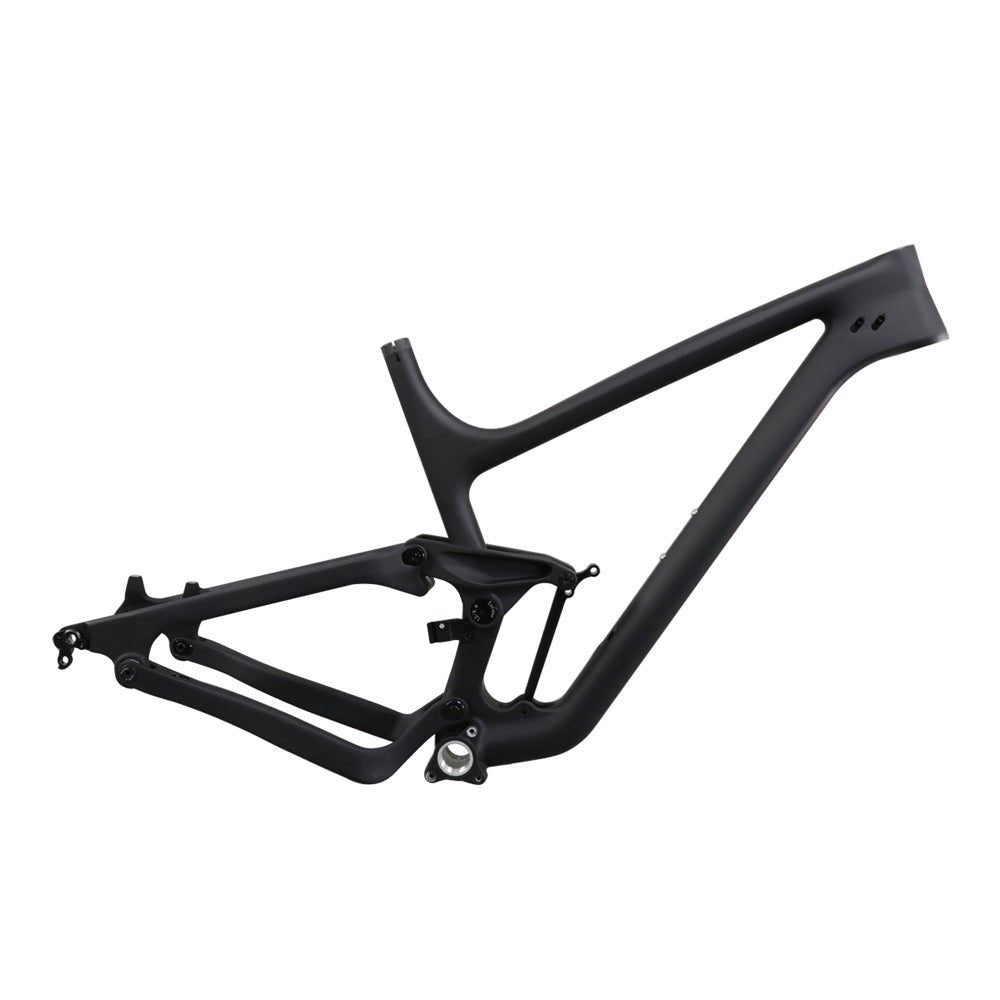
Trail P1 130mm

- Description
- Customer Reviews
- Shipping + Returns Policy
US Warehouse option is for the shipping address within the mainly of the United States.
Click Here To Custom Paint
Specification, returns policy.
You may return most new, unopened items within 30 days of delivery for a full refund. We'll also pay the return shipping costs if the return is a result of our error (you received an incorrect or defective item, etc.).
You should expect to receive your refund within four weeks of giving your package to the return shipper, however, in many cases you will receive a refund more quickly. This time period includes the transit time for us to receive your return from the shipper (5 to 10 business days), the time it takes us to process your return once we receive it (3 to 5 business days), and the time it takes your bank to process our refund request (5 to 10 business days).
If you need to return an item, simply login to your account, view the order using the 'Complete Orders' link under the My Account menu and click the Return Item(s) button. We'll notify you via e-mail of your refund once we've received and processed the returned item.
We can ship to virtually any address in the world. Note that there are restrictions on some products, and some products cannot be shipped to international destinations.
When you place an order, we will estimate shipping and delivery dates for you based on the availability of your items and the shipping options you choose. Depending on the shipping provider you choose, shipping date estimates may appear on the shipping quotes page.
Please also note that the shipping rates for many items we sell are weight-based. The weight of any such item can be found on its detail page. To reflect the policies of the shipping companies we use, all weights will be rounded up to the next full pound.
Recently Viewed Products

is added to your shopping cart.
- MAGAZINE OFFERS
- BIKE INSURANCE
- Best Products
- Maintenance
- Accessories
- Long-Term Reviews
- BikeRadar Podcast
- First Look Friday
- Bike of the Week
- Tech Features
- Routes and Rides
- Bike Galleries
- BikeRadar Bargains
- Buyer's Guides
- Fitness & Training
- Sizing & Fit
- Mountain Biking UK
- Cycling Plus
How much suspension travel do I need on my mountain bike?
From cross-country to downhill, we take you through how much travel you can expect on the major types of mountain bike
Andy Lloyd / Our Media
Mountain bikes feature different amounts of suspension travel depending on the type of riding they're designed for.
Suspension travel describes the amount of movement a suspension fork or rear shock has. It is usually a measurement of how far the wheel axle moves in a vertical or near-vertical plane as the suspension compresses.
Depending on the discipline of riding the bike is designed for, the suspension travel can vary from 80 to 200mm. While more travel may seem better, helping you soak up lumps and bumps, it can be a hindrance if your riding includes lots of climbing or you benefit from a light, responsive bike.
This means deciding on the right amount of travel for your needs can be difficult, but there are a few factors to keep in mind, including your riding style and the type of trails and terrain you'll be tackling.
Bike manufacturers design their mountain bikes around different travel lengths, tailored to specific terrains or riding disciplines, and categorise the bikes accordingly. As a result, looking at the different categories of mountain bikes, their intended application and travel length is a handy way to determine how much travel you need and what bike you should get.
In this guide, we’ll explain the different mountain bike categories and how much suspension travel they typically have.
Cross-country mountain bikes

The best cross-country mountain bikes are designed to compete in high-level, fast races, where lightness and pedalling efficiency are often the keys to success.
Typically, cross-country bikes have featured 80 to 100mm of travel. Because cross-country race courses have become more extreme and technical, it is now common to see bikes designed around 120mm travel front and rear, such as Scott’s Spark RC .
Using less suspension travel than other mountain bikes means cross-country bikes can be built with a lighter frame construction because less reinforcement is needed to deal with the lower frame articulation. This helps riders race up the kinds of inclines that characterise XC races .
The short-travel forks used on cross-country bikes also help to keep weight down because they utilise a lighter chassis and narrower stanchions, usually 30 to 32mm in diameter.
Stanchions are the part of the fork connected to the crown and remain rigid to the bike while the lowers move up and down over them.
The trade-off for this weight saving comes in the form of fork flex, which impacts the directness of steering inputs and the overall ability of the fork to perform in gnarlier terrain as friction levels build on the seals.
A short-travel fork will also run out of travel quicker compared to one with more travel. Although setup and damper performance will dictate a lot of factors in how proficiently it absorbs bumps, less travel means it won't absorb bigger bumps as well as a long-travel fork.
Hardtail mountain bikes are also well-represented in cross-country, because rigid frames allow for the highest pedalling efficiency. However, the traction and descending ability of full-suspension bikes make them desirable to many riders.
Downcountry mountain bikes

Downcountry bikes aim to balance a cross-country bike's efficiency with a trail bike's downhill capability.
‘Downcountry’ is a relatively new mountain bike discipline and isn’t that well defined as a result. But in terms of suspension, these bikes range from beefed up cross-country at 110mm of travel, to lightweight trail with around 130mm front and rear travel.
Having slightly more travel than an outright cross-country bike means downcountry bikes are more capable on descents. However, with shorter travel than trail bikes, they still offer greater pedalling efficiency than burlier bikes.
Downcountry bike frames can be made lighter than trail bikes because the demand on the frame is less. This means they require less material in their construction because they don’t require the same amount of strength as a trail or enduro bike needs.
Downcountry bikes usually feature stronger, stiffer forks, with thicker stanchions, usually 34mm in diameter. This gives higher levels of rigidity to the fork, making steering inputs more direct, although concessions are still made to weight savings.
Trail mountain bikes
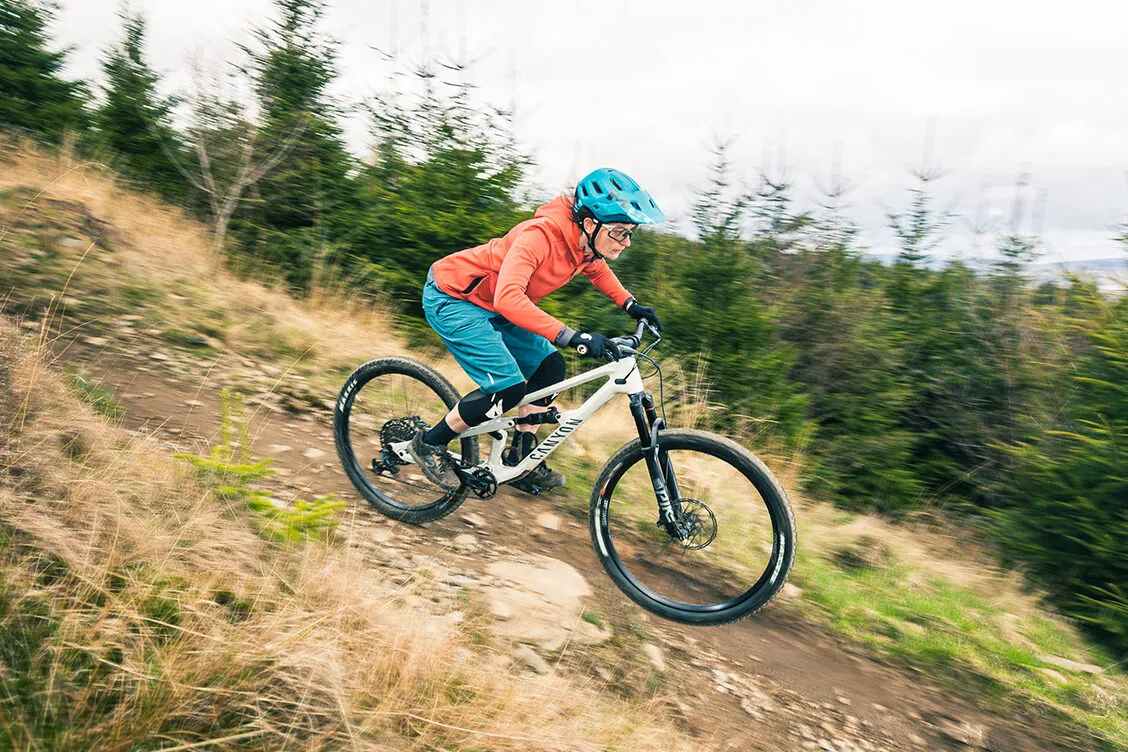
Trail bikes are one of the most popular types of mountain bike. They are designed to straddle the line between enduro bikes and cross-country bikes, providing a ride that’s fun but capable.
Confident on descents and fairly capable on climbs, trail bikes typically have between 120 and 160mm of suspension travel.
Trail bikes at the longer end of the suspension-travel spectrum cross the boundary into all-mountain. Typically, these bikes will feature beefier frame construction to deal with the added suspension travel.
The optimum amount of travel depends on what terrain or trails you like to ride, and where you’d like to progress with your riding. 140mm is ideal for even the toughest trail centres, with more travel being required for gnarlier ambitions.
Forks with mid-sized stanchions, either 34mm, 35mm or 36mm in diameter, are common on trail bikes. These shift the balance away from lightness toward rigid stability for better handling while descending. Less flexibility in the fork will mean more direct steering input, making the bike feel more planted through the rough stuff.
Enduro mountain bikes
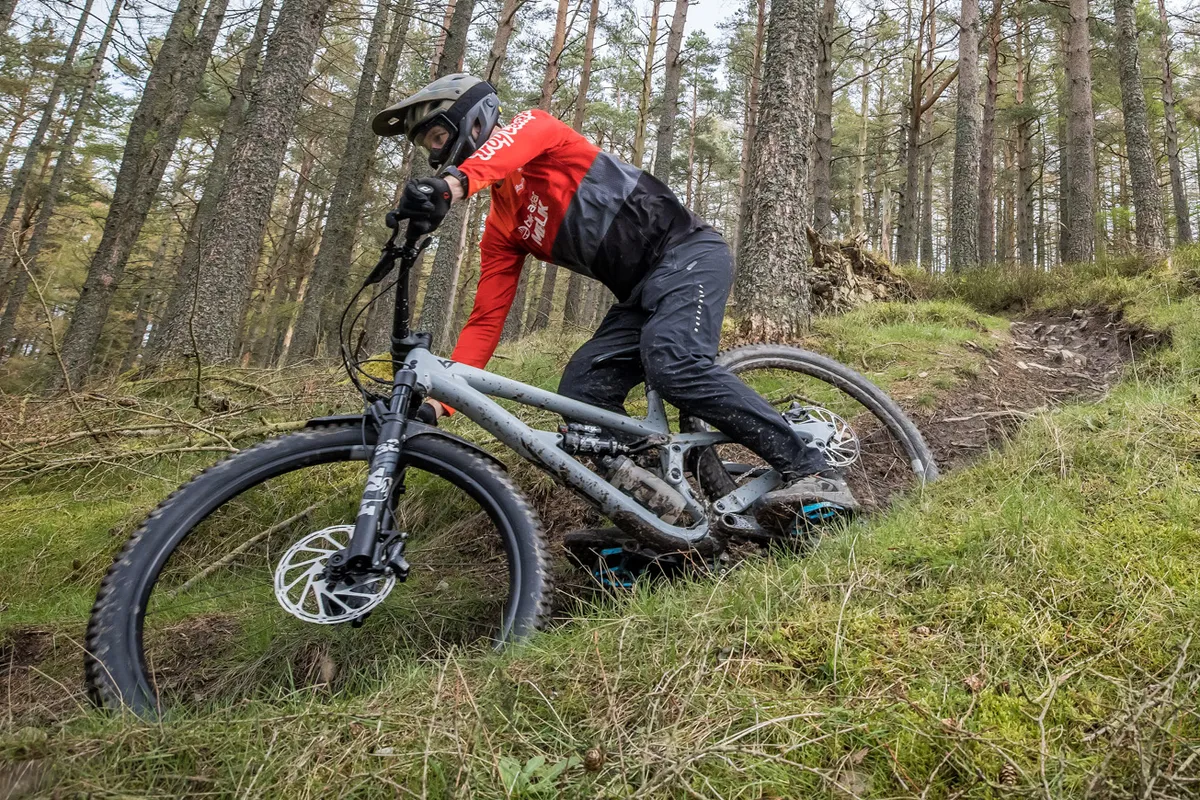
Enduro bikes are designed to meet the demands of enduro racing , which consists of multiple downhill stages that riders have to reach within a set time limit. As a result, enduro bikes have to perform well on technical descents while providing a decent pedalling platform to get you to the top of the trail in good time.
Travel for enduro bikes starts at 150mm and ranges up to 180mm. There is a 190mm-travel version of RockShox’s enduro-focused ZEB fork, but you’re more likely to see this attached to a freeride or bike park bike.
Enduro bikes require a burly frame construction in order to cope with the demands of downhill trails.
Head tubes have to be stronger to deal with the extra force coming from the long-travel fork, while the rear linkage has to be able to support the extra articulation.
This added frame construction makes the frame heavier, impacting efficiency when going uphill, but the pay-off is worth it when coming back down.
Forks within this travel range prioritise rigidity over weight savings, with thicker stanchions of 36mm to 38mm, providing direct steering inputs and a solid feel as you ride over gnarly terrain.
Downhill mountain bikes
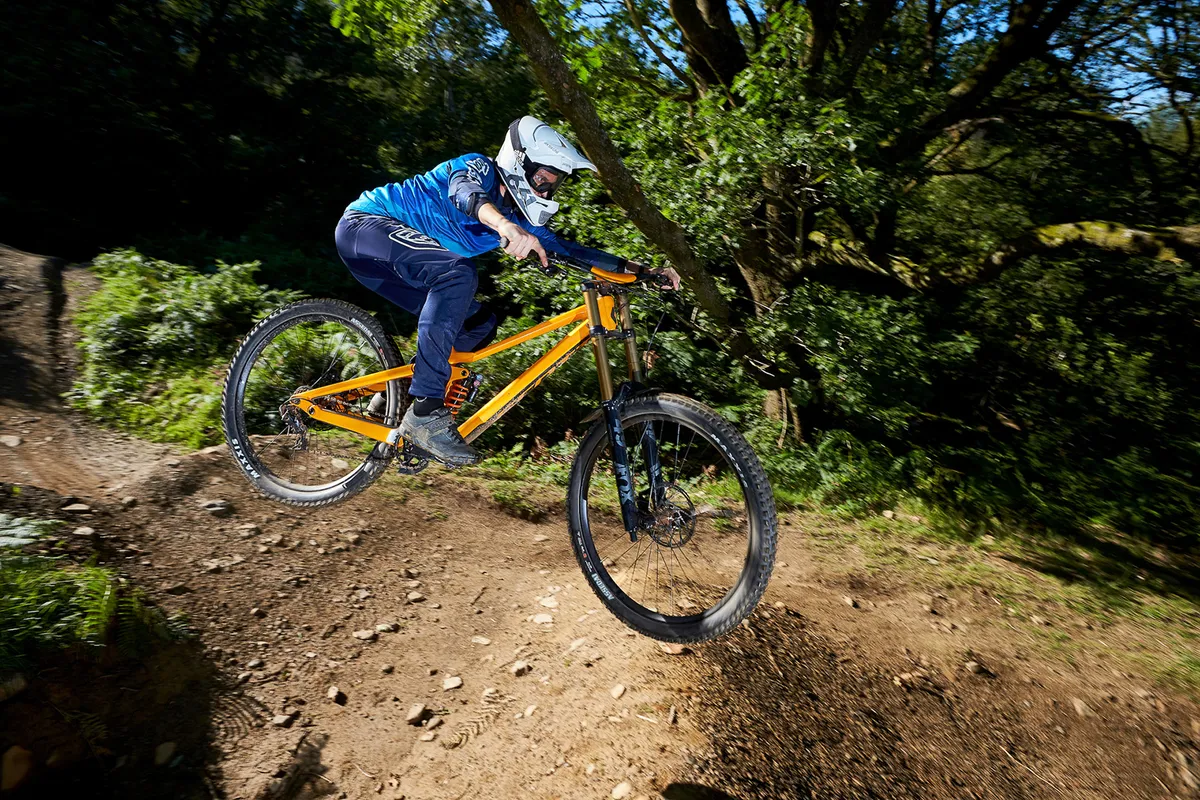
Downhill bikes are designed for, you guessed it, riding downhill. The discipline doesn’t require the bike to be pedalled on uphill or even flat terrain, enabling designers to focus solely on providing the best platform for descending steep and technical trails.
These bikes feature some of the longest suspension travel, ranging from 180 to 200mm, helping to protect riders from large, repeated impacts.
Frames have to be built to the highest strength levels to cope with the impacts you experience on downhill trails. Although downhill frames are heavier than those intended for other disciplines, it's less important to have light frames because you’re not pedalling them uphill.
Downhill forks feature the thickest stanchion, ranging from 35 to 40mm in diameter, because they deal with the most extreme terrain and require the greatest rigidity.
Weight isn’t a big issue for downhill bikes, so the added heft is worth the trade-off for the performance gains.
The forks on downhill bikes have a dual-crown design, meaning the fork mounts above and below the head tube, as opposed to single-crown forks, which mount only from below. This adds more torsional stiffness to the fork, helping to keep steering inputs direct through the toughest terrain and providing strength for big impacts.
Electric mountain bikes
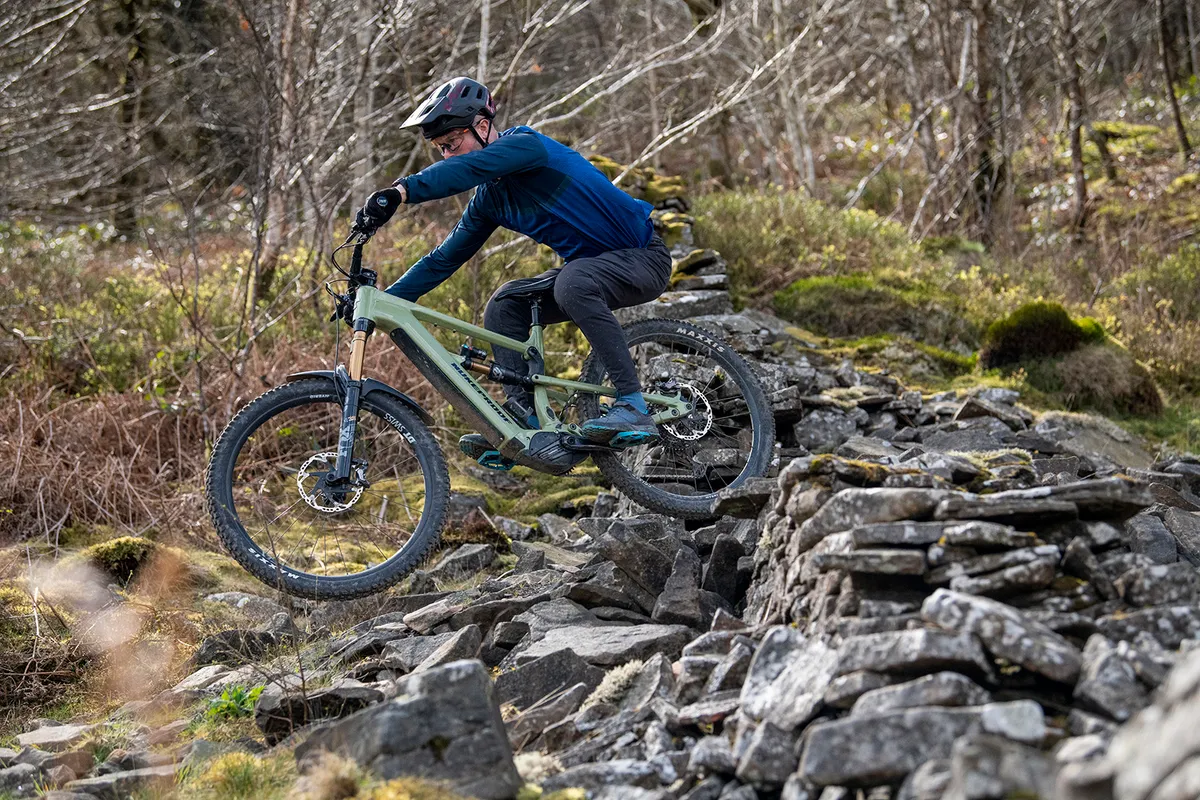
Electric mountain bikes are heavy, even compared to downhill bikes. The added weight a battery and motor bring means frames as well as components have to be engineered to cope with the extra weight – and contribute even more weight to the bike in the process.
Electric bikes can be categorised by the other disciplines featured in this article and will tend to feature the travel of that discipline.
The best electric mountain bikes will feature e-MTB specific forks and shocks, some with thicker stanchions for rigidity, and custom tunes that are suited to the heavier weight of the bike.
Because you’ll have a motor, there won’t be a trade-off in having a bike with more travel (and therefore weight), with the bike taking up the burden on the hills.
What about hardtail mountain bikes?
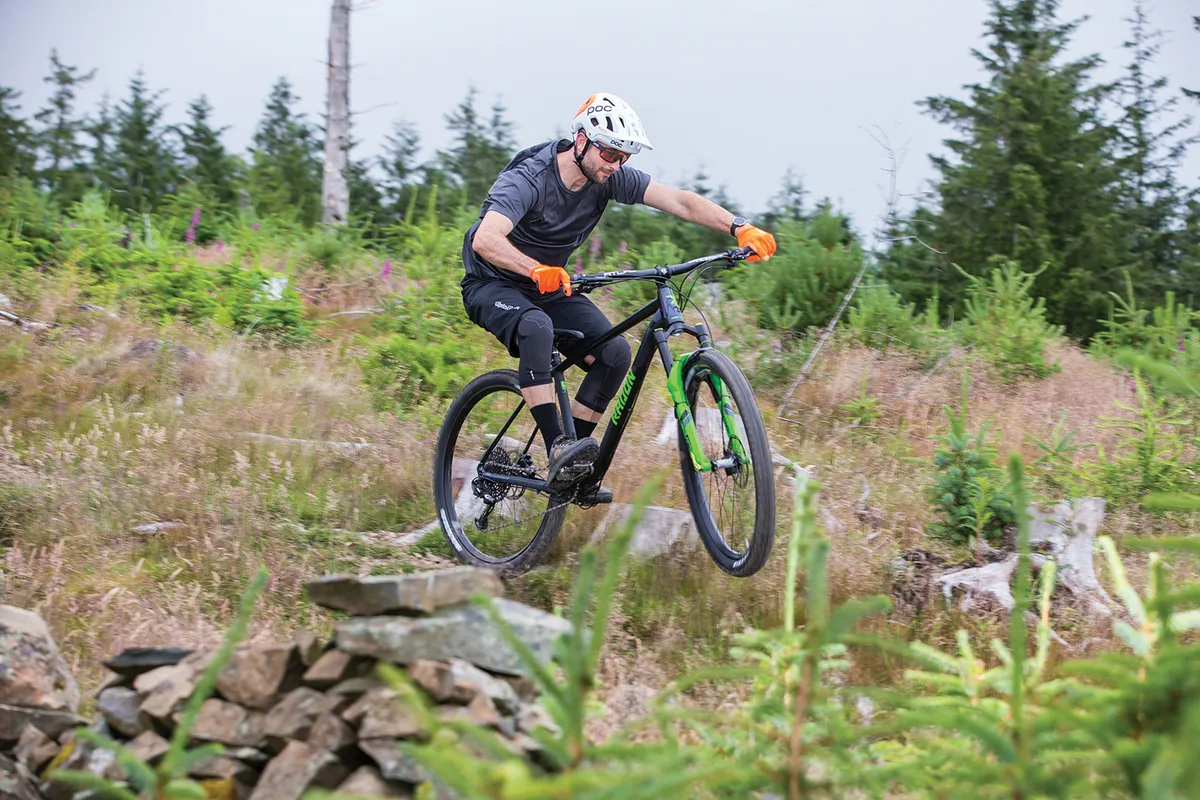
Hardtail mountain bikes have a suspension fork and a rigid rear end. They can be seen in a variety of disciplines, though are mainly represented in the cross-country and trail disciplines. They are also popular when it comes to budget mountain bikes because the simplicity of their design and less suspension means less cost.
As with other types of mountain bikes, fork travel is usually dependent on discipline. Cross-country hardtails typically have 100mm of travel, but more aggressive hardtails can have suspension travel of up to 150mm.
Some manufacturers will design frames with flex points in the rear triangle, allowing for vertical compliance in the frame. This improves comfort when sat in the saddle, and to a smaller extent rear-wheel traction while climbing.
Share this article

Digital Writer

- Terms & Conditions
- Subscribe to our magazines
- Manage preferences
- Yekaterinburg
- Novosibirsk
- Vladivostok

- Tours to Russia
- Practicalities
- Russia in Lists
Rusmania • Deep into Russia
Out of the Centre
Savvino-storozhevsky monastery and museum.

Zvenigorod's most famous sight is the Savvino-Storozhevsky Monastery, which was founded in 1398 by the monk Savva from the Troitse-Sergieva Lavra, at the invitation and with the support of Prince Yury Dmitrievich of Zvenigorod. Savva was later canonised as St Sabbas (Savva) of Storozhev. The monastery late flourished under the reign of Tsar Alexis, who chose the monastery as his family church and often went on pilgrimage there and made lots of donations to it. Most of the monastery’s buildings date from this time. The monastery is heavily fortified with thick walls and six towers, the most impressive of which is the Krasny Tower which also serves as the eastern entrance. The monastery was closed in 1918 and only reopened in 1995. In 1998 Patriarch Alexius II took part in a service to return the relics of St Sabbas to the monastery. Today the monastery has the status of a stauropegic monastery, which is second in status to a lavra. In addition to being a working monastery, it also holds the Zvenigorod Historical, Architectural and Art Museum.
Belfry and Neighbouring Churches

Located near the main entrance is the monastery's belfry which is perhaps the calling card of the monastery due to its uniqueness. It was built in the 1650s and the St Sergius of Radonezh’s Church was opened on the middle tier in the mid-17th century, although it was originally dedicated to the Trinity. The belfry's 35-tonne Great Bladgovestny Bell fell in 1941 and was only restored and returned in 2003. Attached to the belfry is a large refectory and the Transfiguration Church, both of which were built on the orders of Tsar Alexis in the 1650s.

To the left of the belfry is another, smaller, refectory which is attached to the Trinity Gate-Church, which was also constructed in the 1650s on the orders of Tsar Alexis who made it his own family church. The church is elaborately decorated with colourful trims and underneath the archway is a beautiful 19th century fresco.
Nativity of Virgin Mary Cathedral

The Nativity of Virgin Mary Cathedral is the oldest building in the monastery and among the oldest buildings in the Moscow Region. It was built between 1404 and 1405 during the lifetime of St Sabbas and using the funds of Prince Yury of Zvenigorod. The white-stone cathedral is a standard four-pillar design with a single golden dome. After the death of St Sabbas he was interred in the cathedral and a new altar dedicated to him was added.

Under the reign of Tsar Alexis the cathedral was decorated with frescoes by Stepan Ryazanets, some of which remain today. Tsar Alexis also presented the cathedral with a five-tier iconostasis, the top row of icons have been preserved.
Tsaritsa's Chambers

The Nativity of Virgin Mary Cathedral is located between the Tsaritsa's Chambers of the left and the Palace of Tsar Alexis on the right. The Tsaritsa's Chambers were built in the mid-17th century for the wife of Tsar Alexey - Tsaritsa Maria Ilinichna Miloskavskaya. The design of the building is influenced by the ancient Russian architectural style. Is prettier than the Tsar's chambers opposite, being red in colour with elaborately decorated window frames and entrance.

At present the Tsaritsa's Chambers houses the Zvenigorod Historical, Architectural and Art Museum. Among its displays is an accurate recreation of the interior of a noble lady's chambers including furniture, decorations and a decorated tiled oven, and an exhibition on the history of Zvenigorod and the monastery.
Palace of Tsar Alexis

The Palace of Tsar Alexis was built in the 1650s and is now one of the best surviving examples of non-religious architecture of that era. It was built especially for Tsar Alexis who often visited the monastery on religious pilgrimages. Its most striking feature is its pretty row of nine chimney spouts which resemble towers.

Plan your next trip to Russia
Ready-to-book tours.
Your holiday in Russia starts here. Choose and book your tour to Russia.
REQUEST A CUSTOMISED TRIP
Looking for something unique? Create the trip of your dreams with the help of our experts.
Follow Puck Worlds online:
- Follow Puck Worlds on Twitter
Site search
Filed under:
- Kontinental Hockey League
Gagarin Cup Preview: Atlant vs. Salavat Yulaev
Share this story.
- Share this on Facebook
- Share this on Twitter
- Share this on Reddit
- Share All sharing options
Share All sharing options for: Gagarin Cup Preview: Atlant vs. Salavat Yulaev
Gagarin cup (khl) finals: atlant moscow oblast vs. salavat yulaev ufa.
Much like the Elitserien Finals, we have a bit of an offense vs. defense match-up in this league Final. While Ufa let their star top line of Alexander Radulov, Patrick Thoresen and Igor Grigorenko loose on the KHL's Western Conference, Mytischi played a more conservative style, relying on veterans such as former NHLers Jan Bulis, Oleg Petrov, and Jaroslav Obsut. Just reaching the Finals is a testament to Atlant's disciplined style of play, as they had to knock off much more high profile teams from Yaroslavl and St. Petersburg to do so. But while they did finish 8th in the league in points, they haven't seen the likes of Ufa, who finished 2nd.
This series will be a challenge for the underdog, because unlike some of the other KHL teams, Ufa's top players are generally younger and in their prime. Only Proshkin amongst regular blueliners is over 30, with the work being shared by Kirill Koltsov (28), Andrei Kuteikin (26), Miroslav Blatak (28), Maxim Kondratiev (28) and Dmitri Kalinin (30). Oleg Tverdovsky hasn't played a lot in the playoffs to date. Up front, while led by a fairly young top line (24-27), Ufa does have a lot of veterans in support roles: Vyacheslav Kozlov , Viktor Kozlov , Vladimir Antipov, Sergei Zinovyev and Petr Schastlivy are all over 30. In fact, the names of all their forwards are familiar to international and NHL fans: Robert Nilsson , Alexander Svitov, Oleg Saprykin and Jakub Klepis round out the group, all former NHL players.
For Atlant, their veteran roster, with only one of their top six D under the age of 30 (and no top forwards under 30, either), this might be their one shot at a championship. The team has never won either a Russian Superleague title or the Gagarin Cup, and for players like former NHLer Oleg Petrov, this is probably the last shot at the KHL's top prize. The team got three extra days rest by winning their Conference Final in six games, and they probably needed to use it. Atlant does have younger regulars on their roster, but they generally only play a few shifts per game, if that.
The low event style of game for Atlant probably suits them well, but I don't know how they can manage to keep up against Ufa's speed, skill, and depth. There is no advantage to be seen in goal, with Erik Ersberg and Konstantin Barulin posting almost identical numbers, and even in terms of recent playoff experience Ufa has them beat. Luckily for Atlant, Ufa isn't that far away from the Moscow region, so travel shouldn't play a major role.
I'm predicting that Ufa, winners of the last Superleague title back in 2008, will become the second team to win the Gagarin Cup, and will prevail in five games. They have a seriously well built team that would honestly compete in the NHL. They represent the potential of the league, while Atlant represents closer to the reality, as a team full of players who played themselves out of the NHL.
- Atlant @ Ufa, Friday Apr 8 (3:00 PM CET/10:00 PM EST)
- Atlant @ Ufa, Sunday Apr 10 (1:00 PM CET/8:00 AM EST)
- Ufa @ Atlant, Tuesday Apr 12 (5:30 PM CET/12:30 PM EST)
- Ufa @ Atlant, Thursday Apr 14 (5:30 PM CET/12:30 PM EST)
Games 5-7 are as yet unscheduled, but every second day is the KHL standard, so expect Game 5 to be on Saturday, like an early start.
The Unique Burial of a Child of Early Scythian Time at the Cemetery of Saryg-Bulun (Tuva)
<< Previous page
Pages: 379-406
In 1988, the Tuvan Archaeological Expedition (led by M. E. Kilunovskaya and V. A. Semenov) discovered a unique burial of the early Iron Age at Saryg-Bulun in Central Tuva. There are two burial mounds of the Aldy-Bel culture dated by 7th century BC. Within the barrows, which adjoined one another, forming a figure-of-eight, there were discovered 7 burials, from which a representative collection of artifacts was recovered. Burial 5 was the most unique, it was found in a coffin made of a larch trunk, with a tightly closed lid. Due to the preservative properties of larch and lack of air access, the coffin contained a well-preserved mummy of a child with an accompanying set of grave goods. The interred individual retained the skin on his face and had a leather headdress painted with red pigment and a coat, sewn from jerboa fur. The coat was belted with a leather belt with bronze ornaments and buckles. Besides that, a leather quiver with arrows with the shafts decorated with painted ornaments, fully preserved battle pick and a bow were buried in the coffin. Unexpectedly, the full-genomic analysis, showed that the individual was female. This fact opens a new aspect in the study of the social history of the Scythian society and perhaps brings us back to the myth of the Amazons, discussed by Herodotus. Of course, this discovery is unique in its preservation for the Scythian culture of Tuva and requires careful study and conservation.
Keywords: Tuva, Early Iron Age, early Scythian period, Aldy-Bel culture, barrow, burial in the coffin, mummy, full genome sequencing, aDNA
Information about authors: Marina Kilunovskaya (Saint Petersburg, Russian Federation). Candidate of Historical Sciences. Institute for the History of Material Culture of the Russian Academy of Sciences. Dvortsovaya Emb., 18, Saint Petersburg, 191186, Russian Federation E-mail: [email protected] Vladimir Semenov (Saint Petersburg, Russian Federation). Candidate of Historical Sciences. Institute for the History of Material Culture of the Russian Academy of Sciences. Dvortsovaya Emb., 18, Saint Petersburg, 191186, Russian Federation E-mail: [email protected] Varvara Busova (Moscow, Russian Federation). (Saint Petersburg, Russian Federation). Institute for the History of Material Culture of the Russian Academy of Sciences. Dvortsovaya Emb., 18, Saint Petersburg, 191186, Russian Federation E-mail: [email protected] Kharis Mustafin (Moscow, Russian Federation). Candidate of Technical Sciences. Moscow Institute of Physics and Technology. Institutsky Lane, 9, Dolgoprudny, 141701, Moscow Oblast, Russian Federation E-mail: [email protected] Irina Alborova (Moscow, Russian Federation). Candidate of Biological Sciences. Moscow Institute of Physics and Technology. Institutsky Lane, 9, Dolgoprudny, 141701, Moscow Oblast, Russian Federation E-mail: [email protected] Alina Matzvai (Moscow, Russian Federation). Moscow Institute of Physics and Technology. Institutsky Lane, 9, Dolgoprudny, 141701, Moscow Oblast, Russian Federation E-mail: [email protected]
Shopping Cart Items: 0 Cart Total: 0,00 € place your order
Price pdf version
student - 2,75 € individual - 3,00 € institutional - 7,00 €

Copyright В© 1999-2022. Stratum Publishing House

IMAGES
VIDEO
COMMENTS
Best XC Full-Suspension Mountain Bike. Aluminum / 12-Speed Shimano Deore / 29×2.35″. MSRP: $3,599. Jenson USA. Fork: Fox 32 Float Rhythm, 120mm travel. Shock: Fox i-Line DPS Performance, 120mm travel. Wheels: Orbea OC1 25c. The Orbea Oiz H20 is a sleek full-suspension XC bike built for speed and efficiency. With a premium aluminum frame ...
The Ibis Ripmo XT is one of the industry's best high-travel trail mountain bikes. Ibis are masters in designing top-level MTBs, and the Ripmo is a perfect example of their expertise in action, starting from the original version.. The Ripmo uses a Fox Float X2 147mm rear shock paired with a 160mm 38 Factory fork. These parts link with Ibis' DW-Link suspension platform that simultaneously ...
The Izzo is YT's debut into the lightweight full-suspension bike category is a seriously fun yet surprisingly fast machine. At 130mm of travel front and rear and 12.5kg in weight, this may not be a pure-bred race bike. However, it can still handle those marathon days and keep up with the fast guys on climbs before shredding them on the descents.
Most XC bikes feature less than 130mm of suspension travel and are best suited for flowing singletrack and fire road climbs. When the goal is to do-it-all in style, Trail & All-Mountain bikes are up for the job. Suspension travel ranges 130-170mm, and most bikes are designed to efficiently climb and descend all manner of technical terrain.
Wheel size: 29in | Frame sizes: S, M, L, XL | Weight: 13.65kg (30.09lb) | Suspension travel: 150mm f/130mm r | Rating: 10/10. Reasons to buy: Fast and capable; Built-in suspension data acquisition; ... First and foremost, control. Full suspension bikes track the ground better and as such offer greater traction. Full-suspension bikes are more ...
130mm travel size. max tire size: 27.5 *2.8'' or 29* 2.3''. Recommended Matched mountain wheels: Trail F730, Trail F930. P1 complete bike are available in stock!. Compare P1 and P9. P1 has 130mm travel and P9 has 150mm travel distance. P1 have 51mm rear shock travel,but P9 is 55mm. P1 is suitable for trail roads, P9 is suitable for enduro riding.
The Giant Stance is a lightweight full suspension trail bike that's built around an alloy frame, a 130mm travel fork, and 120mm of rear wheel travel. FlexPoint vs Maestro. While the two bikes share similar travel and intentions, the big difference between the Trance and the Stance can be found in the rear suspension layout.
The YT Izzo is a 130mm travel trail bike, designed around a pair of 29" wheels only, and available in either full carbon, or a carbon and alloy hybrid frame. The Izzo uses a Horst Link suspension design to control the 130mm of travel as you'd expect from YT, but with a different arrangement using a rocker link and vertical shock instead of ...
With 130mm of front and rear wheel travel, this lightweight carbon 29er is YT's most trail-oriented model, with a fairly modern geometry that lends itself more toward the XC side of the trail riding spectrum. Weighing in at just 27.5 pounds in the size large we tested, it's also the lightest trail bike we've ever tested. ... Full Suspension vs ...
Yeti SB120 T1 GX X01. $7,600 at Jenson USA. Although the new SB120—a 29er trail bike with 120mm rear travel and a 130mm fork—replaces the SB115 as the Yeti's shortest-travel full suspension ...
The 27 VR comes with 130mm in the frame travel, matched with X-Fusion suspension to keep you planted when the trails get rough. ... Accessible Full Suspension Trail Bike. Modern Geometry paired with Proven 4-Bar Suspension Design. Frame Material. 6061-T6 Aluminium Alloy. Suspension Travel. 130mm Front, 130mm Rear. Wheel Size. 27.5. Available ...
Giant Trance X 29. The Izzo is designed to "not be as modern". It's not a 130mm trail bike it's a 130mm "downcountry" bike, which means it values pedaling as well as really active riders who are pickin the bike up, hoppin over features, choosing lines intelligently, and basically just fit to be honest.
The 'Multitrac' frame gives 130mm of travel and while it comes with a 141mm QR rear it can be upgraded to a full 148mm width Boost bolted thru-axle. Suspension is taken care of by the Slide Boost RC fork with 140mm travel, and the X-Fusion O2 Pro R shock. ... All the budget full-suspension bikes tested here have been ridden on a wide range of ...
No more than 120mm of suspension travel at either end. The archetypal down-country bike should have closer to 100mm of rear travel. And if there's a 130mm travel fork up front, it's ruled out. Usually. There are some outliers than we allow into the down-country fold. Otherwise the whole thing just gets far too close to a regular trail bike.
With 140mm of front travel and 130mm rear, the Habit Waves floats over hazards and obstacles with ease and charges down trails with speed. Admittedly, the 6061 aluminum frame isn't the lightest on the market, but it's tough and ready to take on the mountains. As an introductory full-suspension MTB, it offers excellent value for money.
TREK FUEL EX 5 GEN 5 REVIEW. With trail bikes in Trek's lineup reaching five-digit prices, it is nice to see the industry giant offer a full-suspension trail bike that doesn't break the bank. Trek was kind enough to send us the Fuel EX 5 to ride and review in our budget-bike shoot-out. At just under $2,500, the Fuel EX 5 is one of the most ...
Click Here To Custom Paint Specification Type Full Carbon Suspension MTB frame Model P1 Wheel Size 27.5er/29er Material 100% carbon fiber Toray T700 Weave UD Matt Frame Travel 130mm Brake Front 180mm, Rear 160mm Rear Shock 200*51mm Frame Weight 2410g (M, UDM), 2445g(S, Pink) Frame Size XS/S/M/L/XL Bottom Bracket BSA Headset Top 1-1/8",down 1- 1 ...
How much suspension travel do I need on my mountain bike? | BikeRadar.
Elektrostal , lit: Electric and Сталь , lit: Steel) is a city in Moscow Oblast, Russia, located 58 kilometers east of Moscow. Population: 155,196 ; 146,294 ...
Zvenigorod's most famous sight is the Savvino-Storozhevsky Monastery, which was founded in 1398 by the monk Savva from the Troitse-Sergieva Lavra, at the invitation and with the support of Prince Yury Dmitrievich of Zvenigorod. Savva was later canonised as St Sabbas (Savva) of Storozhev. The monastery late flourished under the reign of Tsar ...
Much like the Elitserien Finals, we have a bit of an offense vs. defense match-up in this league Final. While Ufa let their star top line of Alexander Radulov, Patrick Thoresen and Igor Grigorenko loose on the KHL's Western Conference, Mytischi played a more conservative style, relying on veterans such as former NHLers Jan Bulis, Oleg Petrov, and Jaroslav Obsut.
Burial 5 was the most unique, it was found in a coffin made of a larch trunk, with a tightly closed lid. Due to the preservative properties of larch and lack of air access, the coffin contained a well-preserved mummy of a child with an accompanying set of grave goods. The interred individual retained the skin on his face and had a leather ...